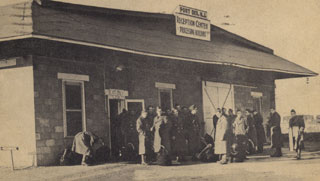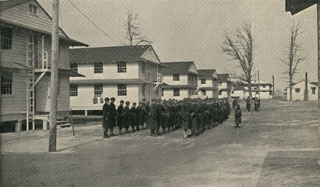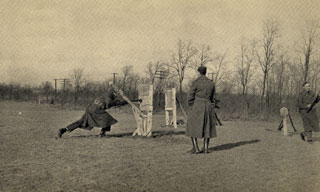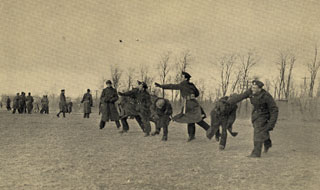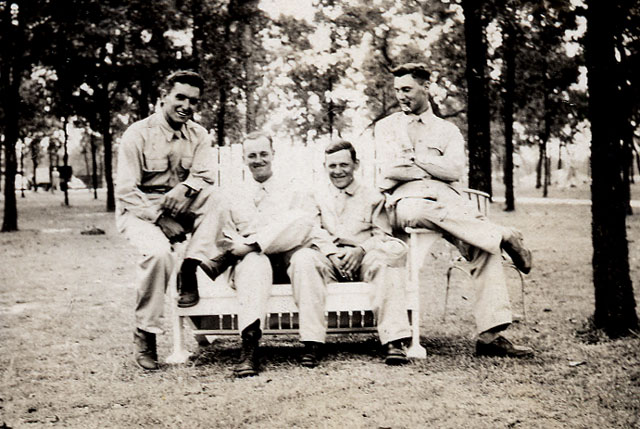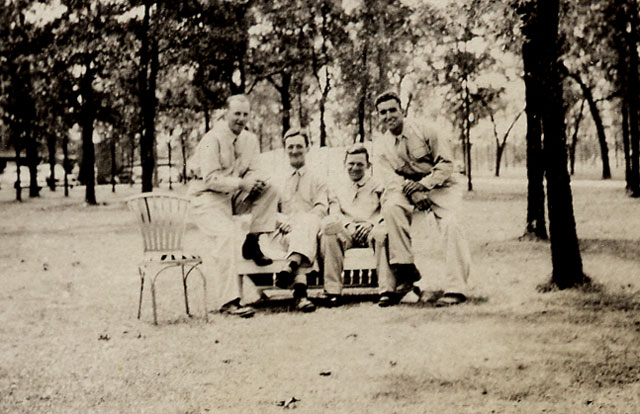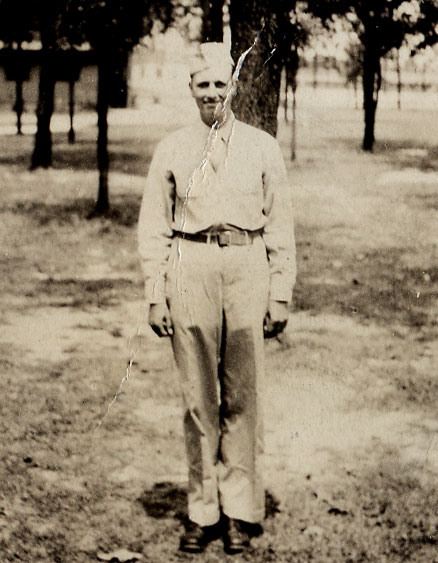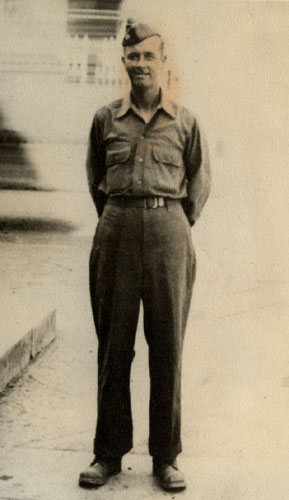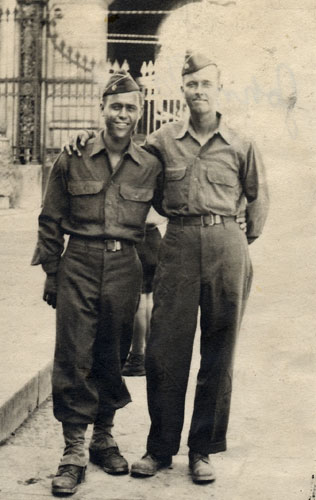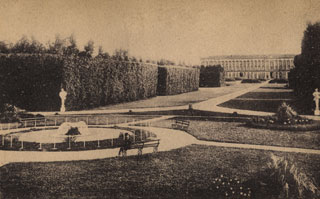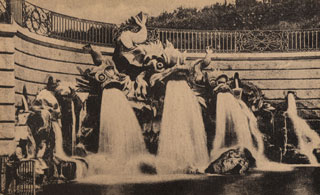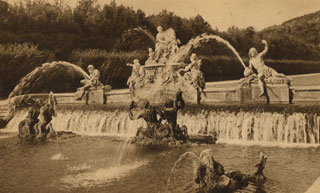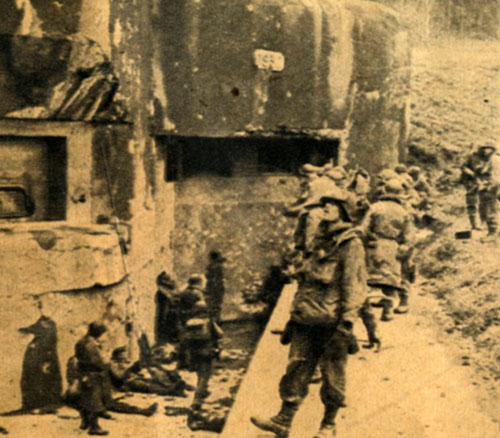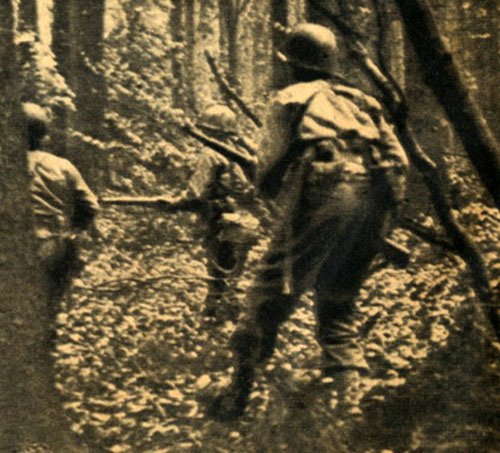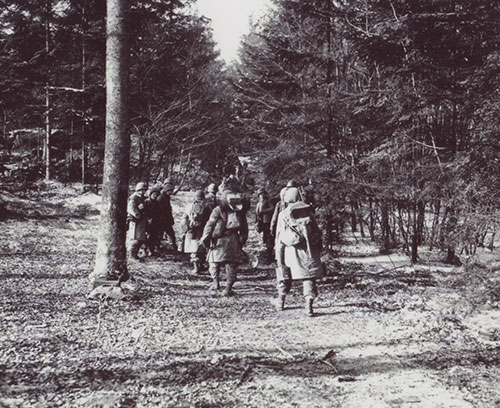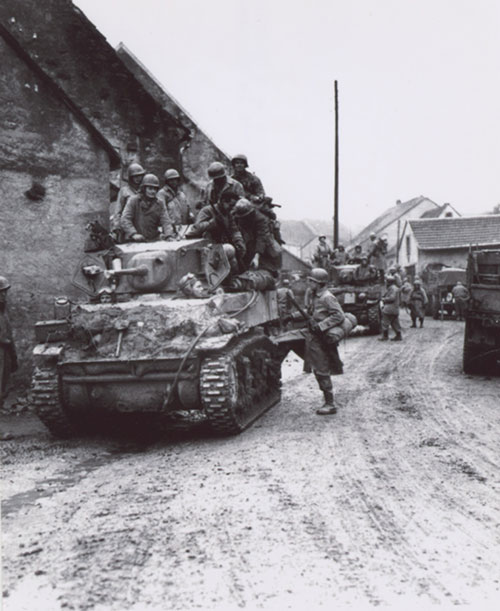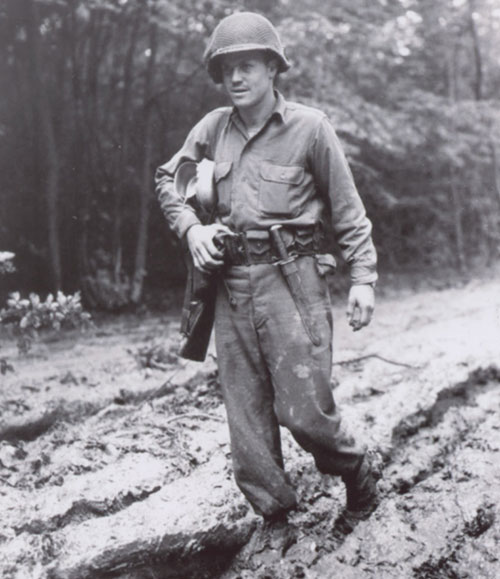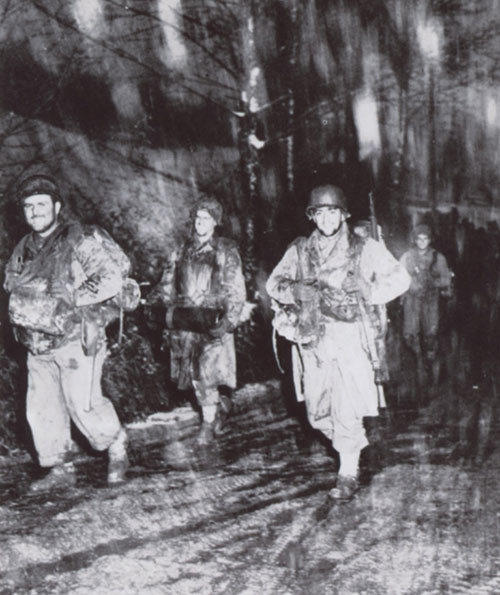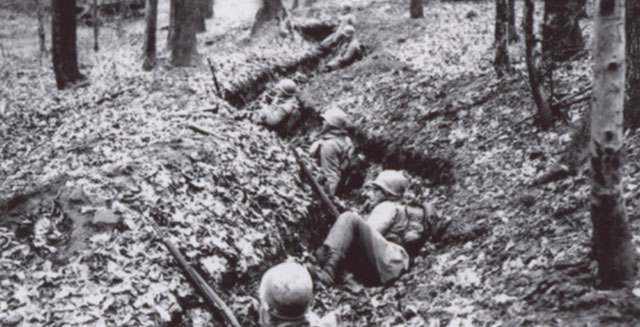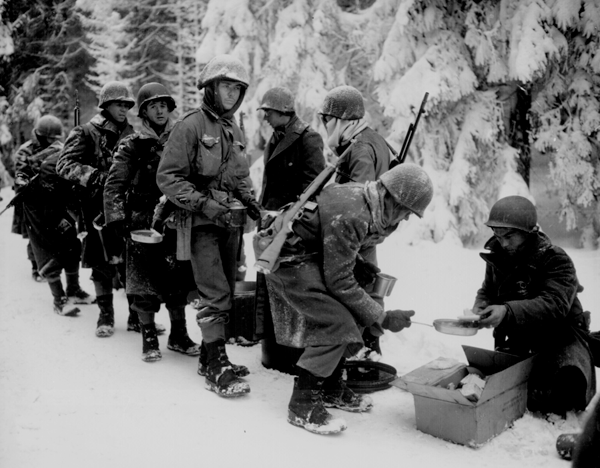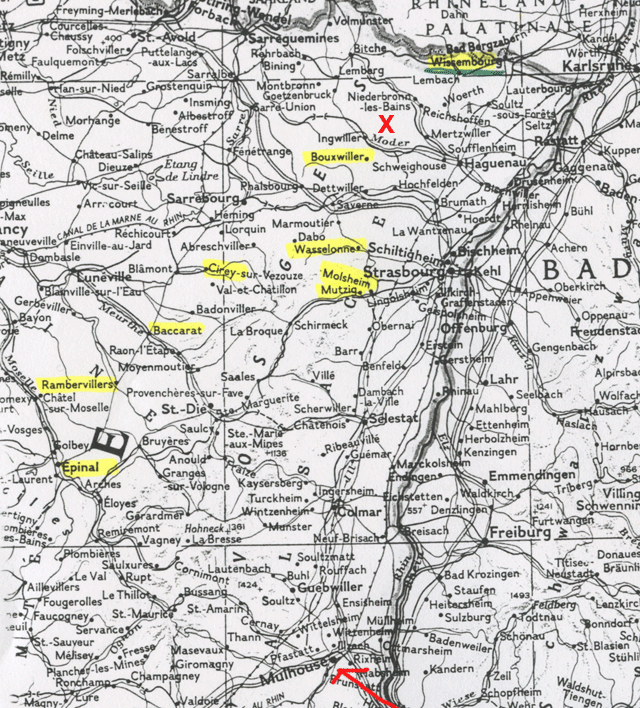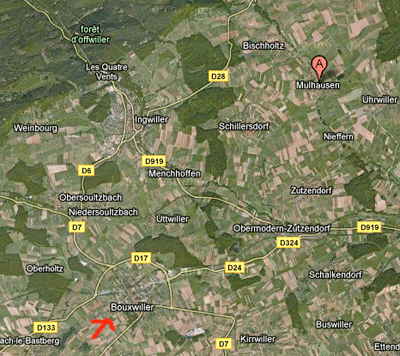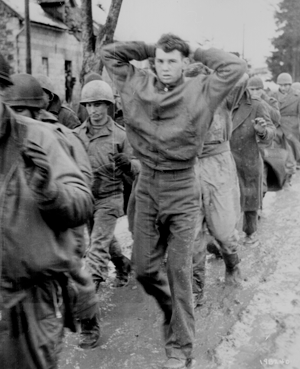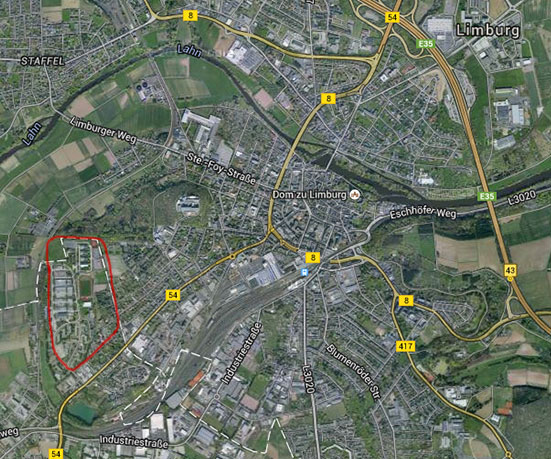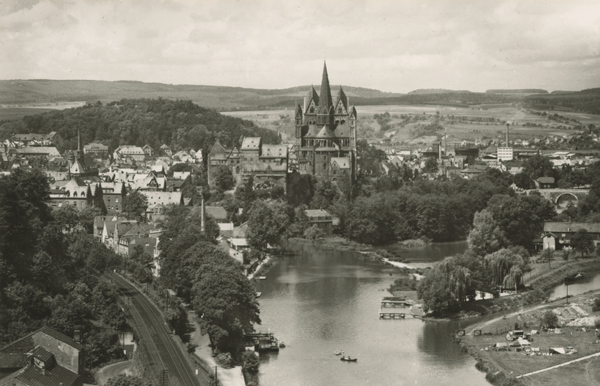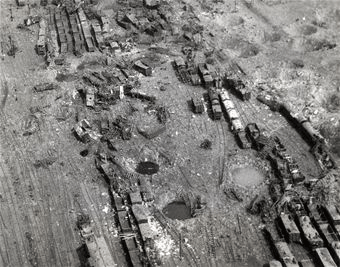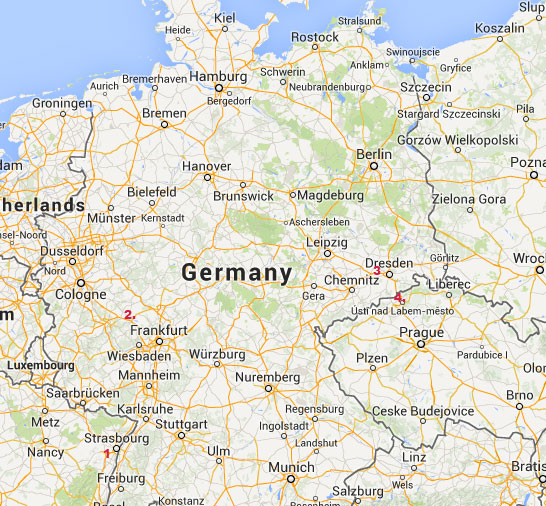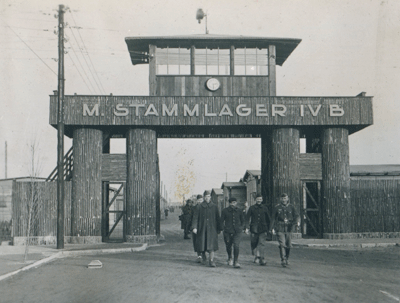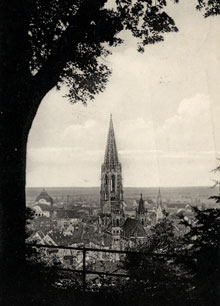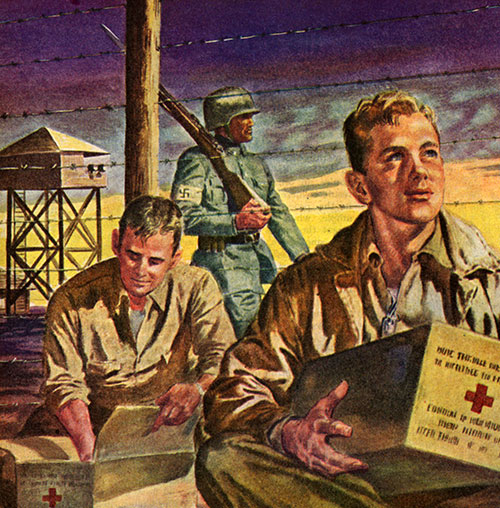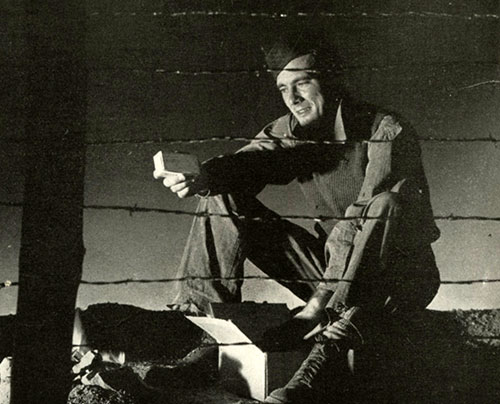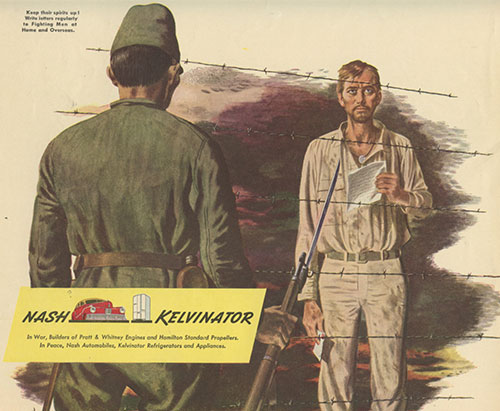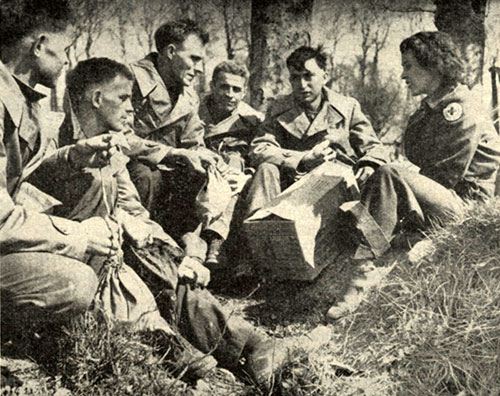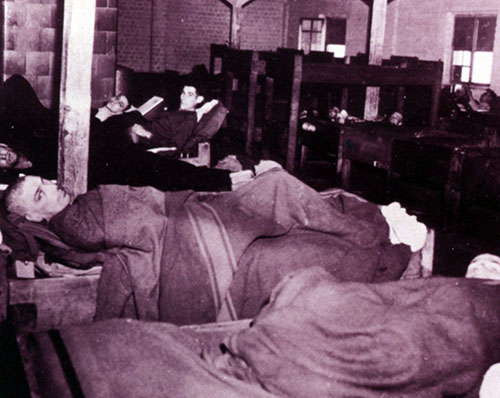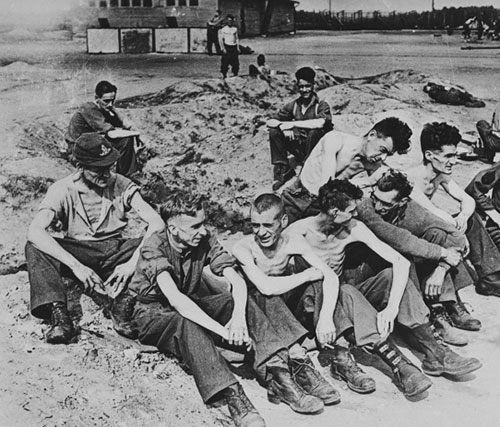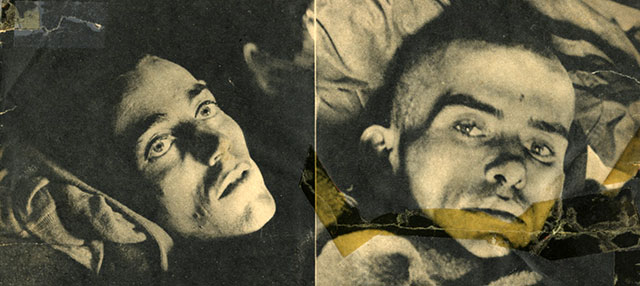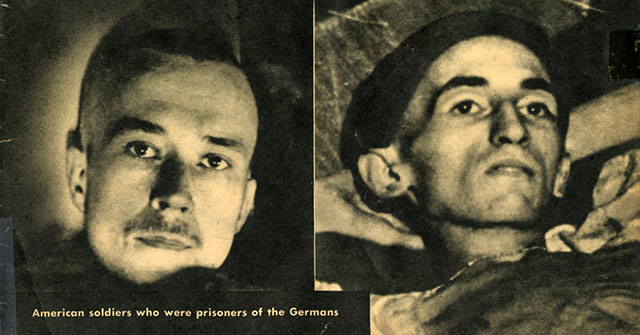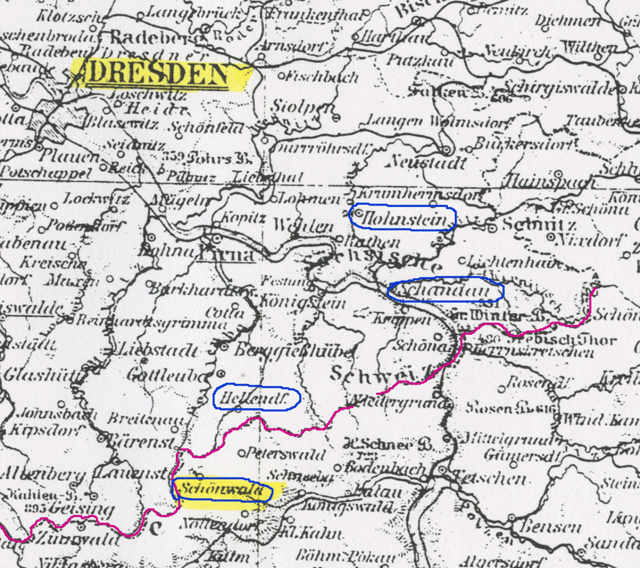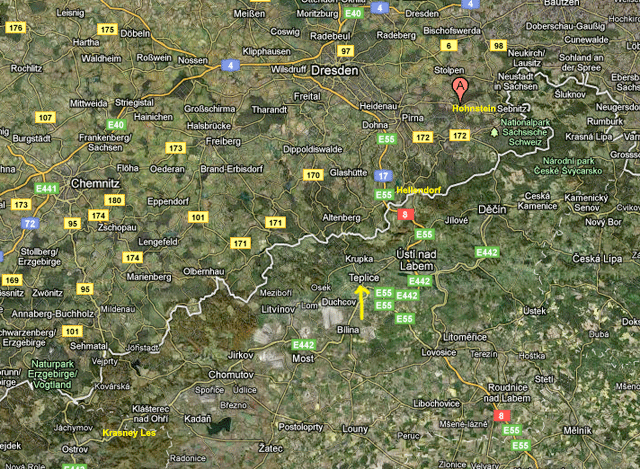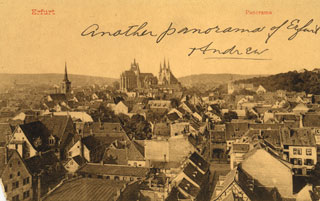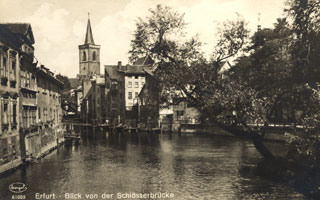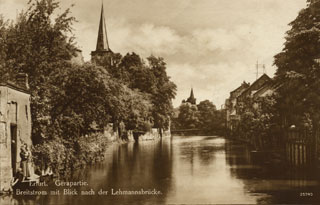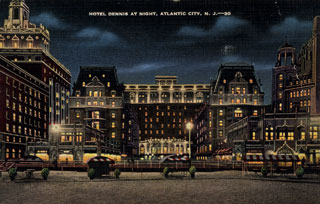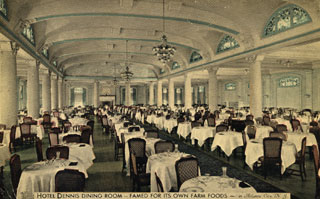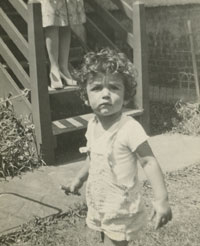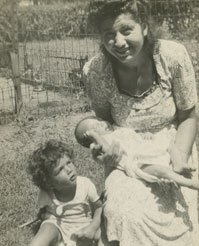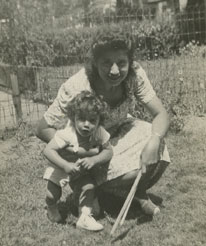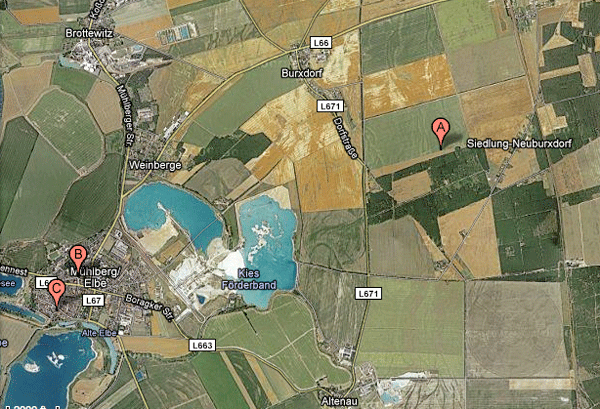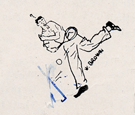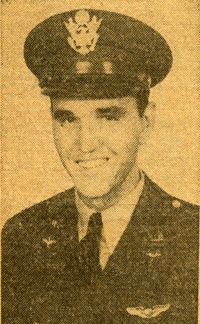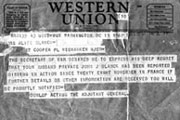-
Roy Wesley Baggett (1920-1983)
Association with John Blanck: Same division, same date of capture, POW camp Stalag IVB.
Birth: September 26, 1920, Tennessee
Enlistment: November 21, 1942
Roy W Baggett
Birth Year:
1920
Race:
White, citizen (White)
Nativity State or Country:
Tennessee
State of Residence:
Tennessee
County or City:
Houston Enlistment Date:
21 Nov 1942
Enlistment State:
Georgia
Enlistment City:
Fort Oglethorpe
Branch:
Branch Immaterial - Warrant Officers, USA
Branch Code:
Branch Immaterial - Warrant Officers, USA
Grade:
Private
Grade Code:
Private
Term of Enlistment:
Enlistment for the duration of the War or other emergency, plus six months, subject to the discretion of the President or otherwise according to law
Component:
Selectees (Enlisted Men)
Source:
Civil Life Education:
Grammar school
Civil Occupation:
Unskilled lumbermen, raftsmen, and woodchoppers
Marital Status:
Married
Height:
72
Weight:
151
Dog Tags: 34494732
Division: 179th Infantry
Capture: Nov 28, 1944
Camp: #006, Stalag 4B Muhlberg Sachsen 51-13.
WWII POW: Roy W Baggett,
Report Date: 28 Nov 1944,
Latest Report Date: Jun 1945,
Grade: Private First Class,
Grade Notes: Second Lieutenant or Nurse or Dietitian or Physical therapy
aide or Private First Class or Ensign or Second Class, Seaman,
Service Branch: Army,
Arm or Service: Infantry,
Arm or Service Code: Infantry,
Organization Type: Branch Immaterial/Infantry Division Band/Dental Corps/Medical Department,
Parent Unit Type: Group/Regiment/Commands/System,
Area Served: European Theatre: France,
Detaining Country: Germany,
Camp: 006,
Status: Returned to Military Control, Liberated or Repatriated,
Report Source: Individual has been reported through sources considered official.
NARA POW Record:
BAGGETT ROY W
Private First Class
ARMY
Infantry
ARM OR SERVICE CODE
10
INF: INFANTRY
DATE REPORT: DAY
28
MONTH
11
YEAR
1944
TYPE OF ORGANIZATION
740
Branch Immaterial/Infantry Division Band/Dental Corps/Medical Department
PARENT UNIT NUMBER
0179
PARENT UNIT TYPE
06
Group/Regiment/Commands/System
AREA
76
European Theatre: France
LATEST REPORT DATE: DAY (DD)
09
LATEST REPORT DATE: MONTH (MM)
06
LATEST REPORT DATE: YEAR (Y)
1945
SOURCE OF REPORT
1
Individual has been reported through sources considered official.
STATUS
8
Returned to Military Control, Liberated or Repatriated
DETAINING POWER
1
GERMANY
CAMP
006
Stalag 4B Muhlberg Sachsen 51-13
Return Stateside: Not listed on Ancestry.com under this spelling as of February 2010
Last Report Date: June 9, 1945
Death: Roy Baggett
BIRTH: 26 Sep 1920
DEATH: Dec 1983 - Erin, Houston, Tennessee, United States of America
CIVIL: Tennessee
More:
Find a Grave includes an obituaty which mentions that he was a veteran of WWII
does not mention that he was a POW.
-
Thomas F Belli (1914-1945)
Association with John Blanck: Same division, same capture date, Stalag IVB, mentioned in John's
diary "(Tom Belli) who trained with me in the states and who use to be in the same fox hole together- to be exact we were captured together.
Birth: 1914, New York
According to the 1930 census, Thomas Belli was the son of
Joseph and Ida Belli of Thursby Ave Queens.
Marriage:
Mariam
After 1942? Not listed in NYC grooms which go up to 1942.
Child: A daughter according to John's diary.
Enlistment: 29 Dec 1943
Thomas F Belli,
Birth Year:
1914,
Race:
Nativity State or Country:
New York,
State of Residence:
New York,
County or City:
Queens Enlistment Date:
29 Dec 1943,
Enlistment State:
New York,
Enlistment City:
New York City,
Branch:
No branch assignment,
No branch assignment
Grade:
Private,
Term of Enlistment:
Enlistment for the duration of the War or other emergency, plus six months, subject to the discretion of the President or otherwise according to law
Component:
Civil Life Education:
1 year of high school,
Civil Occupation:
Firemen, fire department,
Marital Status:
Single, without dependents
Height:
00
Weight:
000
Dog Tags: 42062616
Division: 179th
Capture: November 28, 1944
April 1945:
12 Queens soldiers previously reported as missing in action
were said to be prisoners of war.
Thomas F. Belli, private, husband of Marion Belli of 516 Beach 72nd street.
ARVERNE SOLDIER CAPTURED IN FRANCE
Private Thomas F. Belli of Arverne was taken prisoner by the Germans Nov. 28 in France while fighting
as an infantryman with the 7th Army.
A native of Arverne, he attended Public School 42 in that community and later was graduated
for Browne's Business School Jamaica. Before he
entered the Army in January 1944 he was employed at
Fort Tilden, Rockaway Point. He went overseas in August.
Private Belli's wife, the former
Marion Intrabartola, lives with their 2-year-old daughter Marion, at 526
Beach 72nd street, next door to her parents, Mr. and Mrs. Dominick Intrabargola.
Private
Belli's parents are Mr. and Mrs. Joseph Belli of 69-42 Thursday Avenue, Arverne.
Camp: #006, Stalag 4B Muhlberg Sachsen 51-13.
WWII POW: Thomas F Belli,
Report Date: 28 Nov 1944,
Latest Report Date: 12 Oct 1945,
Grade: Private,
Grade Notes: Second Lieutenant or Nurse or Dietitian or Physical therapy aide or
Private First Class or Ensign or Second Class, Seaman,
Service Branch: Army,
Arm or Service: Infantry,
Arm or Service Code: Infantry,
Organization Type: Infantry,
Parent Unit Type: 4E,
Area Served: European Theatre: France,
Detaining Country: Germany,
Camp: 006,
Status: Returned to Military Control, Liberated or Repatriated,
Report Source: Individual has been reported through sources considered official.
NARA POW Record:
SERIAL NUMBER
42062616
BELLI THOMAS F
GRADE, ALPHA
PVT
Private
GRADE CODE
7
Second Lieutenant or Nurse or Dietitian or Physical therapy aide or Private First Class or Ensign or Second Class, Seaman
SERVICE CODE
1
ARMY
Infantry
ARM OR SERVICE CODE
10
INF: INFANTRY
DATE REPORT: DAY
28
MONTH
11
YEAR
1944
TYPE OF ORGANIZATION
22P
Infantry
PARENT UNIT NUMBER
0179
PARENT UNIT TYPE
4E
Undefined Code
AREA
76
European Theatre: France
LATEST REPORT DATE: DAY (DD)
12
LATEST REPORT DATE: MONTH (MM)
10
LATEST REPORT DATE: YEAR (Y)
1945
SOURCE OF REPORT
1
Individual has been reported through sources considered official.
STATUS
8
Returned to Military Control, Liberated or Repatriated
DETAINING POWER
1
GERMANY
CAMP
006
Stalag 4B Muhlberg Sachsen 51-13
Return Stateside: He died in Europe the day after the war was over.
Thomas and John trained together in the states, were in the same same fox
hole when they were captured.
Death: John's Journal
May 21, 1945
"Routine the same today just eating and resting. Raining most of the
day went to bed very early- very cold. Heard some very bad news yesterday one of
the boys who was at a prison camp in Germany with a fellow (Tom Belli) who trained
with me in the states and who use to be in the same fox hole together- to be exact
we were captured together. The day after the war was over he was riding in a G.I.
truck which was strafed + bombed by a Russian planes (mistake) truck turned over
and he was killed. It was a shock he had a wife and baby daughter.
Again I realize how good God has been to me."
Tom Belli did NOT die in May 1945. He died in June 1970.
Listed in his obituary as: a WWII veteran, a member of the Disabled
American Veterans,
the son of Joseph and Ida Belli and
the husband of Marion. He had two daughters, both married. He also left
three grandsons.
Thomas F Belli,
Birth Date: 2 Apr 1914,
Age at Death: 56,
Death Date: 18 Jun 1970,
Burial Place: Farmingdale, Suffolk County, New York, USA
More:
Marian Belli,
Service Info.:
PVT US ARMY,
Birth Date:
24 Nov 1917,
Death Date:
20 Sep 1991,
Relation:
Wife of Belli, Thomas F,
Interment Date:
24 Sep 1991,
Cemetery:
Long Island National Cemetery,
Cemetery Address:
2040 Wellwood Avenue Farmingdale, NY 11735-1211
Buried At:
Section 2x Site 3950
Thomas F. Belli Pvt deceased was awarded the Conspicuous Service Cross #18394 +1 Sil Device on 10 March 1971.
mailed to C/O William McLaughlin 253-08 147th Road Rosedale, NY 11422.
The Conspicuous Service Cross is awarded to those members of the New York Organised Militia
who were prisoners of war. It is also awarded for other merit.
-
Leonard Hamilton Berry, Sr. (1914-1986)
Association with John Blanck: Same division, same capture date, Stalag IVB.
Birth: 1914
Enlistment:
Leonard H Berry Sr
Birth Year:
1914,
Nativity State or Country:
Virginia,
State of Residence:
Georgia,
County or City:
Mc Duffee,
Enlistment Date:
18 Jan 1944,
Enlistment State:
Georgia,
Enlistment City:
Fort McPherson Atlanta
Branch:
No branch assignment,
Branch Code:
No branch assignment,
Grade:
Private,
Term of Enlistment:
Enlistment for the duration of the War or other emergency, plus six months, subject to the discretion of the President or otherwise according to law
Component:
Selectees (Enlisted Men)
Source:
Civil Life, Education:
4 years of high school
Civil Occupation:
Managers and officials, n.e.c.
Marital Status:
Married
Height:
00
Weight:
000
Dog Tags: 34834730
Division: 179th
Capture: November 28, 1922
Camp: BERRY LEONARD H SR, PVT camp #006, Stalag 4B Muhlberg Sachsen 51-13.
WWII POW:
Leonard H Sr Berry,
Report Date: 28 Nov 1944,
Latest Report Date: Jun 1945,
Grade: Private,
Grade Notes: Cadet, USMA or Chief Warrant Officer or
Private or Apprentice, Seaman,
Service Branch: Army,
Arm or Service: Infantry,
Arm or Service Code: Infantry,
Organization Type: Branch Immaterial/Infantry Division Band/Dental
Corps/Medical Department,
Parent Unit Type: Group/Regiment/Commands/System,
Area Served: European Theatre: France,
Detaining Country: Germany,
Camp: 006
Status: Returned to Military Control, Liberated or Repatriated,
Report Source: Individual has been reported through sources considered official.
NARA POW Record:
34834730
BERRY LEONARD H SR
GRADE, ALPHA
PVT
Private
GRADE CODE
8
Cadet, USMA or Chief Warrant Officer or Private or Apprentice, Seaman
SERVICE CODE
1
ARMY
Infantry
ARM OR SERVICE CODE
10
INF: INFANTRY
DATE REPORT: DAY
28
MONTH
11
YEAR
1944
TYPE OF ORGANIZATION
740
Branch Immaterial/Infantry Division Band/Dental Corps/Medical Department
PARENT UNIT NUMBER
0179
PARENT UNIT TYPE
06
Group/Regiment/Commands/System
AREA
76
European Theatre: France
LATEST REPORT DATE: DAY (DD)
07
LATEST REPORT DATE: MONTH (MM)
06
LATEST REPORT DATE: YEAR (Y)
1945
SOURCE OF REPORT
1
Individual has been reported through sources considered official.
STATUS
8
Returned to Military Control, Liberated or Repatriated
DETAINING POWER
1
GERMANY
CAMP
006
Stalag 4B Muhlberg Sachsen 51-13
Return Stateside: Not listed on Ancestry.com under this spelling as of February 2010
Last Report Date: June 7, 1945
Death: Leonard H Berry
Death Date:
2 Dec 1986
County of Death:
Richmond
Gender:
M (Male)
Race:
White
Age:
72 years
County of Residence:
McDuffie
Certificate:
045663
Date Filed:
16 Dec 1986
Leonard Berry Sr.,
SSN: 226-05-9846,
Last Residence: 30824 Thomson, Mcduffie, Georgia, USA,
BORN: 7 Sep 1914,
Died: Dec 1986,
State (Year) SSN issued: Virginia (Before 1951)
More: Mrs. Frances Lambertson Berry
EVANS, Ga. - Mrs. Frances Lambertson Berry, 95, passed away peacefully Sunday, September 12, 2010, at her residence at Brandon Wilde in Evans.
Mrs. Berry, who resided in Thomson for over 50 years, was preceded in death by her husband, Leonard Hamilton Berry of Thomson, and her eldest son, Leonard Hamilton Berry, Jr., of Australia. She is survived by her son, Dr. Robert E. (Vickie) Berry of Thomson; her daughter, Mrs. Marion (Jo Ann) Crolley of Cramerton, NC; and her daughter-in-law, Mrs. Leonard (Diana Newport) of Australia. She is also survived by eight grandchildren and five great-grandchildren. Mrs. Berry was a member of First Baptist Church of Thomson. She was a former member of the Captain John Wilson Chapter of the Daughters of the American Revolution. Arrangements for a memorial service are pending.
McDuffie
-
John Blanck (1915-1976)
Birth: 1915 New Jersey
Enlistment: 14 Jan 1944
U.S. World War II Army Enlistment Records, 1938-1946 Record:
John J Blanck, Birth Year: 1915 Race: White, citizen Nativity State
or Country: New Jersey State: New Jersey County or City: Hudson,
Enlistment Date: 14 Jan 1944 Enlistment State: New Jersey Enlistment City:
Newark Branch: No branch assignment Branch Code: No branch assignment Grade: Private Grade Code: Private Term of Enlistment: Enlistment for the duration of the War or other emergency, plus six months, subject to the discretion of the President or otherwise according to law Component: Selectees (Enlisted Men) Source: Civil Life, Education: 4 years of high school, Civil Occupation: Laboratory Technician, Motion Picture or Shipping Clerk, Marital Status: Single, without
dependents, Height: 06 Weight: 000
Dog Tags: 42104261
Division: 179
Capture: November 28, 1944
Camp: #006, Stalag 4B Muhlberg Sachsen 51-13.
WWII POW:
John J Blanck,
Report Date: 28 Nov 1944,
Latest Report Date: 26 Jun 1945,
Grade: Private,
Grade Notes: Cadet, USMA or Chief Warrant Officer or Private or Apprentice, Seaman,
Service Branch: Army,
Arm or Service: Infantry,
Arm or Service Code: Infantry,
Organization Type: Branch Immaterial/Infantry Division Band/Dental Corps/Medical Department,
Parent Unit Type: Group/Regiment/Commands/System,
Area Served: European Theatre: France,
Detaining Country: Germany,
Camp: 006,
Status: Returned to Military Control, Liberated or Repatriated,
Report Source: Individual has been reported through sources considered official.
NARA POW Record:
NARA POW Record: 42104261 NAME BLANCK JOHN J GRADE, ALPHA PVT Private GRADE CODE 8 Cadet, USMA or Chief Warrant Officer or Private or Apprentice, Seaman SERVICE CODE 1 ARMY Infantry ARM OR SERVICE CODE 10 INF: INFANTRY DATE REPORT: DAY (DD) 28 DATE REPORT: MONTH (MM) 11 DATE REPORT: YEAR (Y) 1944 TYPE OF ORGANIZATION 740 Branch Immaterial/Infantry Division Band/Dental Corps/Medical Department PARENT UNIT NUMBER 0179 0179 PARENT UNIT TYPE 06 Group/Regiment/Commands/System AREA 76 European Theatre: France LATEST REPORT DATE: DAY (DD) 26 LATEST REPORT DATE: MONTH (MM) 06 LATEST REPORT DATE: YEAR (Y) 1945 SOURCE OF REPORT 1 Individual has been reported through sources considered official. STATUS 8 Returned to Military Control, Liberated or Repatriated DETAINING POWER 1 GERMANY CAMP 006
Stalag 4B Muhlberg Sachsen 51-13
Return Stateside: June 12, 1945, Admiral Benson
Last Report Date: June 26, 1945
Death: Labor Day, September 3, 1976, Belmar, New jersey
More:
-
John W Booth
Common name.
Association with John Blanck:
Same division, same capture date, same camp
Birth:
Enlistment:
Dog Tags: 36901139
Division: 179th
Capture: November 28, 1944
Camp: #006, Stalag 4B Muhlberg Sachsen 51-13.
WWII POW:
John W Booth,
Report Date: 28 Nov 1944,
Latest Report Date: 20 Jul 1945,
Grade: Private,
Grade Notes: Cadet, USMA or Chief Warrant Officer or Private or Apprentice, Seaman,
Service Branch: Army,
Arm or Service: Infantry,
Arm or Service Code: Infantry,
Organization Type: Branch Immaterial/Infantry Division Band/Dental Corps/Medical Department,
Parent Unit Type: Group/Regiment/Commands/System,
Area Served: European Theatre: France,
Detaining Country: Germany,
Camp: 006,
Status: Returned to Military Control, Liberated or Repatriated
Report Source: Individual has been reported through sources considered official.
NARA POW Record:
SERIAL NUMBER
36901139
BOOTH JOHN W
GRADE, ALPHA
PVT
Private
GRADE CODE
8
Cadet, USMA or Chief Warrant Officer or Private or Apprentice, Seaman
SERVICE CODE
1
ARMY
Infantry
ARM OR SERVICE CODE
10
INF: INFANTRY
DATE REPORT: DAY
28
MONTH
11
YEAR
1944
TYPE OF ORGANIZATION
740
Branch Immaterial/Infantry Division Band/Dental Corps/Medical Department
PARENT UNIT NUMBER
0179
PARENT UNIT TYPE
06
Group/Regiment/Commands/System
AREA
76
European Theatre: France
LATEST REPORT DATE: DAY (DD)
20
LATEST REPORT DATE: MONTH (MM)
07
LATEST REPORT DATE: YEAR (Y)
1945
SOURCE OF REPORT
1
Individual has been reported through sources considered official.
STATUS
8
Returned to Military Control, Liberated or Repatriated
DETAINING POWER
1
GERMANY
CAMP
006
Stalag 4B Muhlberg Sachsen 51-13
Return Stateside: No with that Dog Tag #
Last Report Date: July 20, 1945
Death:
More:
-
Sheppard A Brewster (1924-2000)
Association with John Blanck: Same division, same capture, Stalag IVB
Birth: 1924, New Jersey
Enlistment: 9 Jul 1943
Sheppard A Brewster
Birth Year:
1924
Race:
White, citizen (White)
Nativity State or Country:
New Jersey
State of Residence:
New Jersey
County or City:
Cumberland
Enlistment Date:
9 Jul 1943
Enlistment State:
New Jersey
Enlistment City:
Camden
Branch:
No branch assignment
Branch Code:
No branch assignment
Grade:
Private
Grade Code:
Private
Term of Enlistment:
Enlistment for the duration of the War or other emergency, plus six months, subject to the discretion of the President or otherwise according to law
Component:
Selectees (Enlisted Men)
Source:
Civil Life
Education:
Grammar school
Civil Occupation:
Semiskilled chauffeurs and drivers, bus, taxi, truck, and tractor
Marital Status:
Single, without dependents
Height:
44
Weight:
424
Dog Tags: 32953821
Division: 179th
Capture: November 28, 1944
Camp: BREWSTER SHEPPARD A, PVT, camp #006, Stalag 4B Muhlberg Sachsen 51-13.
WWII POW:
Sheppard A Brewster,
Report Date: 28 Nov 1944,
Latest Report Date: 10 Aug 1945,
Grade: Private,
Grade Notes: Cadet, USMA or Chief Warrant Officer or Private or Apprentice, Seaman,
Service Branch: Army,
Arm or Service: Infantry,
Arm or Service Code: Infantry,
Organization Type: Branch Immaterial/Infantry Division Band/Dental Corps/Medical Department,
Parent Unit Type: Group/Regiment/Commands/System,
Area Served: European Theatre: France,
Detaining Country: Germany,
Camp: 006,
Status: Returned to Military Control, Liberated or Repatriated,
Report Source: Individual has been reported through sources considered official.
NARA POW Record:
32953821
BREWSTER SHEPPARD A
GRADE, ALPHA
PVT
Private
GRADE CODE
8
Cadet, USMA or Chief Warrant Officer or Private or Apprentice, Seaman
SERVICE CODE
1
ARMY
Infantry
ARM OR SERVICE CODE
10
INF: INFANTRY
DATE REPORT: DAY
28
MONTH
11
YEAR
1944
TYPE OF ORGANIZATION
740
Branch Immaterial/Infantry Division Band/Dental Corps/Medical Department
PARENT UNIT NUMBER
0179
PARENT UNIT TYPE
06
Group/Regiment/Commands/System
AREA
76
European Theatre: France
LATEST REPORT DATE: DAY (DD)
10
LATEST REPORT DATE: MONTH (MM)
08
LATEST REPORT DATE: YEAR (Y)
1945
SOURCE OF REPORT
1
Individual has been reported through sources considered official.
STATUS
8
Returned to Military Control, Liberated or Repatriated
DETAINING POWER
1
GERMANY
CAMP
006
Stalag 4B Muhlberg Sachsen 51-13
Return Stateside: Not listed on Ancestry.com under this spelling as of February 2010
Last Report Date: August 10, 1945
Death:
Sheppard A. Brewster
BIRTH: 13 May 1924
DEATH: 10 Feb 2000 - Millville, Cumberland, New Jersey, United States of America
CIVIL: New Jersey
More: Sheppard Brewster,
Gender: Male,
Birth Date: 13 May 1924,
Death Date: 10 Feb 2000,
SSN: 146148256,
Branch 1: ARMY,
Enlistment Date 1: 30 Jul 1943,
Release Date 1: 3 Dec 1945
-
Martin Briede (1912-1972)
Association with John Blanck: Same division, same capture date
Birth:
The only Martin Briede listed by Ancestry.com was born about 1912 in
Cincinnati, Hamilton, Ohio.
SSDI lists 21 Jan 1912 died June 1972, Ohio
Martin Briede of Cincinnati was a bowler.
The 55th American
Bowling Congress tournament in Syracuse New York listed "Martin
Briede of Cincinnati is sixth" in the singles. Hamilton Daily News Journal, Ohio April 1, 1958.
Enlistment: Not listed on Ancestry.com under this spelling as of February 2010
WWII POW:
Martin Briede,
Report Date: 28 Nov 1944,
Latest Report Date: May 1945,
Grade: Private,
Grade Notes: Second Lieutenant or Nurse or Dietitian or Physical therapy aide or Private First
Class or Ensign or Second Class, Seaman,
Service Branch: Army,
Arm or Service: Infantry,
Arm or Service Code: Infantry,
Organization Type: Infantry,
Parent Unit Type: Divisional Artillery,
Area Served: European Theatre: France,
Detaining Country: Germany,
Camp: 062,
Status: Returned to Military Control, Liberated or Repatriated,
Report Source: Individual has been reported through sources considered official.
Dog Tags: 35883316
Division: 179th
Capture:
November 28, 1944
Camp: Stalag 3A and work camps (Also Oflag 3-6) Luckenwalde (was originally interrogation center)
Brandenburg, Prussia 52-13
NARA POW Record:
SERIAL NUMBER
35883316
BRIEDE MARTIN
GRADE, ALPHA
PVT
Private
GRADE CODE
7
Second Lieutenant or Nurse or Dietitian or Physical therapy aide or Private First Class or Ensign or Second Class, Seaman
SERVICE CODE
1
ARMY
Infantry
ARM OR SERVICE CODE
10
INF: INFANTRY
DATE REPORT: DAY
28
MONTH
11
YEAR
1944
TYPE OF ORGANIZATION
22P
Infantry
PARENT UNIT NUMBER
0179
PARENT UNIT TYPE
45
Divisional Artillery
AREA
76
European Theatre: France
LATEST REPORT DATE: DAY (DD)
08
LATEST REPORT DATE: MONTH (MM)
05
LATEST REPORT DATE: YEAR (Y)
1945
SOURCE OF REPORT
1
Individual has been reported through sources considered official.
STATUS
8
Returned to Military Control, Liberated or Repatriated
DETAINING POWER
1
GERMANY
CAMP
062
Stalag 3A and work camps (Also Oflag 3-6) Luckenwalde (was originally interrogation center) Brandenburg, Prussia 52-13
Return Stateside: Not listed on Ancestry.com under this spelling as of February 2010
Last Report Date: May 8, 1945
Death:
Martin J Briede,
Ohio,
June 03, 1972,
Age at Death: 60
More: Martin Briede,
Gender: Male,
Birth Date: 21 Jan 1912,
Death Date: 3 Jun 1972,
SSN: 268100556,
Enlistment Date 1: 17 Jan 1944,
Release Date 1: 17 Jan 1946,
Branch 2: UNK
Martin J Briede,
Birth Date: 1912,
Gender: Male,
Race: White,
Residence Place: Hamilton, Ohio, United States,
Death Date: 3 Jun 1972,
Hospital of Death: Deaconess Hospital,
Death Place: Cincinnati, Hamilton, Ohio, USA,
Certificate: 045058,
Age at Death: 60,
Certifier: Physician,
Autopsy: No Autopsy performed,
Marital Status: Married
Martin Briede,
SSN: 268-10-0556,
BORN: 21 Jan 1912,
Died: Jun 1972,
State (Year) SSN issued: Ohio (Before 1951)
-
John J Callazzo (1911-1957)
Association with John Blanck: Same division, same capture date, Stalag IVB
Birth: 1911, Pennsylvania
Enlistment: 18 Oct 1943
John J Callazzo
Birth Year:
1911
Race:
White, citizen (White)
Nativity State or Country:
Pennsylvania
State of Residence:
Pennsylvania
Enlistment Date:
18 Oct 1943
Enlistment State:
Pennsylvania
Enlistment City:
Philadelphia
Branch:
No branch assignment
Branch Code:
No branch assignment
Grade:
Private
Grade Code:
Private
Term of Enlistment:
Enlistment for the duration of the War or other emergency, plus six months, subject to the discretion of the President or otherwise according to law
Component:
Selectees (Enlisted Men)
Source:
Civil Life
Education:
Grammar school
Civil Occupation:
Bartenders
Marital Status:
Married
Height:
00
Weight:
000
Dog Tags: 33802427
Division: 179th
Capture: November 28, 1944
Camp: CALLAZZO JOHN J, PVT, camp #006, Stalag 4B Muhlberg Sachsen 51-13.
WWII POW:
John J Callazzo,
Report Date: 28 Nov 1944,
Latest Report Date: 12 Jun 1945,
Grade: Private,
Grade Notes: Cadet, USMA or Chief Warrant Officer or Private or Apprentice, Seaman,
Service Branch: Army,
Arm or Service: Infantry,
Arm or Service Code: Infantry,
Organization Type: Branch Immaterial/Infantry Division Band/Dental Corps/Medical Department,
Parent Unit Type: Group/Regiment/Commands/System,
Area Served: European Theatre: France,
Detaining Country: Germany,
Camp: 006,
Status: Returned to Military Control, Liberated or Repatriated,
Report Source: Individual has been reported through sources considered official.
NARA POW Record:
SERIAL NUMBER
33802427
CALLAZZO JOHN J
GRADE, ALPHA
PVT
Private
GRADE CODE
8
Cadet, USMA or Chief Warrant Officer or Private or Apprentice, Seaman
SERVICE CODE
1
ARMY
Infantry
ARM OR SERVICE CODE
10
INF: INFANTRY
DATE REPORT: DAY
28
MONTH
11
YEAR
1944
TYPE OF ORGANIZATION
740
Branch Immaterial/Infantry Division Band/Dental Corps/Medical Department
PARENT UNIT NUMBER
0179
PARENT UNIT TYPE
06
Group/Regiment/Commands/System
AREA
76
European Theatre: France
LATEST REPORT DATE: DAY (DD)
12
LATEST REPORT DATE: MONTH (MM)
06
LATEST REPORT DATE: YEAR (Y)
1945
SOURCE OF REPORT
1
Individual has been reported through sources considered official.
STATUS
8
Returned to Military Control, Liberated or Repatriated
DETAINING POWER
1
GERMANY
CAMP
006
Stalag 4B Muhlberg Sachsen 51-13
Return Stateside: Not listed on Ancestry.com under this spelling as of February 2010
Last Report Date: June 12, 1945
1950:
Application for WWII Compensation Callazzo, John J, 1850 Ashurst Rd. Philadelphia,
born Jan 10, 1911, Service dates, Nov 8, 1943, to July 27, 1944 and June 15, 1945 to Nov 27, 1945,
In foreign service from July 28, 1944 to June 15, 1945.
Death: 1957 application for Head Stone Marker, Callazzo, John J. Inducted 11-18-43 discharged
11-27-45 Service No. 33802427 Pension of Va Claim XL 65
26513, state Penn. Grade, Private 1st Class, Medals Purple Heart with oak -- cluster, US. Army,
Co. F. 1st division, date of birth, 1-10-11, date of death 3-21-57, applicant Mrs. Ethel M Callazzo,
1850 Ashurst St. Philadelphia, burried Holly Cross Cem. Yeadon, Pa.
Wife, Ethel and child Bernadette, total amount due $305.
More:
-
John Desmond Callan (1925-2006)
Association with John Blanck: Stalag IVB
The both mention shoveling coal.
"was later part of forced retreats as the
Allied troops advanced through Germany"
After the war John received a Christmas card from Des Callan
with an image of a soldier behind barbed wire and the message
"For a Better Year".
Birth: 1925
Enlistment: 12 Nov 1943
Desmond Callan
Birth Year:
1925
Race:
White, citizen (White)
Nativity State or Country:
Massachusetts
State of Residence:
Massachusetts
County or City:
Norfolk, Enlistment Date:
12 Nov 1943
Enlistment State:
Massachusetts
Enlistment City:
Fort Devens
Branch Code:
No branch assignment
Grade:
Private
Grade Code:
Private
Term of Enlistment:
Enlistment for the duration of the War or other emergency, plus six months, subject to the discretion of the President or otherwise according to law
Component:
Reserves - exclusive of Regular Army Reserve and Officers of the Officers Reserve Corps on active duty under the Thomason Act (Officers and Enlisted Men -- O.R.C. and E.R.C., and Nurses-Reserve Status)
Source:
Enlisted Reserve or Medical Administrative Corps (MAC) Officer
Education:
4 years of high school
Marital Status:
Single, without dependents
Height:
48
Weight:
046
Dog Tags: 11132799
Division: 0423
Capture: December 21, 1944, Battle of the Bulge
Camp: 006 Stalag 4 B Muhlberg
WWII POW:
NARA POW Record:
Not listed Ancestry, 2014
11132799
11132799
NAME
CALLAN DESMOND
GRADE, ALPHA
PFC
Private First Class
GRADE CODE
7
Second Lieutenant or Nurse or Dietitian or Physical therapy aide or Private First Class or Ensign or Second Class, Seaman
SERVICE CODE
1
ARMY
Infantry
ARM OR SERVICE CODE
10
INF: INFANTRY
DATE REPORT: DAY
21
MONTH
12
YEAR (Y)
1944
TYPE OF ORGANIZATION
740
Branch Immaterial/Infantry Division Band/Dental Corps/Medical Department
PARENT UNIT NUMBER
0423
PARENT UNIT TYPE
06
Group/Regiment/Commands/System
AREA
72
European Theatre: Germany
LATEST REPORT DATE: DAY (DD)
13
LATEST REPORT DATE: MONTH (MM)
06
LATEST REPORT DATE: YEAR (Y)
1945
SOURCE OF REPORT
1
Individual has been reported through sources considered official.
STATUS
8
Returned to Military Control, Liberated or Repatriated
DETAINING POWER
1
GERMANY
CAMP
006
Stalag 4B Muhlberg Sachsen 51-13
Return Stateside: Did not find.
Last Report Date: June 13, 1945
Death: July 22, 2002
Desmond Callan M.D., physician, Hillsdale, N.Y., on July 22, 2002. Callan
proved something of a maverick from the start, forcing the hospital nursery to
shut down in response to his case of newborn impetigo. He spent his early years in
Wellesley, Mass., where his father, a charismatic Episcopal minister from Britain,
served as chaplain of Wellesley College. Callan attended Milton Academy and
entered Harvard University in the fall of 1943. By the end of his first
semester, he had enlisted in the Army, and he arrived in Europe in October 1944.
Two months later, his regiment was forced to surrender to the Germans at the
outset of the Battle of the Bulge. He spent the rest of the war in German
prisoner-of-war camps and on work details in southern and eastern Germany.
The bitter winter weather, combined with the slim rations and harsh conditions - he
shoveled coal at a German factory and was later part of forced retreats as the
Allied troops advanced through Germany - caused his health to fail. By the time
his POW camp near Muhlberg was liberated by Soviet troops in the spring of 1945,
he was suffering from malnutrition, beriberi* and dysentery. In February 1946,
after months of recuperation, he entered the College, gravitating immediately to
student political activities. By this time, he had shed his conservative roots
and embraced the ideals of the left. Callan graduated from the College with
a bachelor's degree in history, but with a wife to support (he was married for the
first time in 1948), he decided to study electronics at a trade school.
He subsequently landed a job as a technician in the neurophysiology lab at
Columbia. In 1956, he entered P&S, graduating in 1960. After his internship,
he served as acting director of the neurology clinic at Columbia-Presbyterian
Medical Center and was later named a director of clinics at Yale University.
By 1963, in addition to his medical duties, Callan had returned to activist politics.
The following year, three young civil rights workers were murdered in Mississippi,
and Callan and a group of other physicians and medical professionals responded
by forming the Medical Committee for Human Rights. By this time, his professional
interests were moving away from neurology, his initial specialty, and toward
the delivery of health care through community centers. He worked for seven
years in administrative medicine at the Martin Luther King community
health center in the Bronx. From 1968Ð70, Callan served as the medical
director of a community health center on the Lower East Side.
He also wrote extensively about national health issues as a staff member
of the progressive medical think tank the Health Policy Advisory Center.
He moved to Columbia County in 1979, opening an office first in South Egremont,
Mass., then in Hillsdale, and finally in Copake Falls. The focus of his
practice was geriatrics and adult patients with chronic illnesses.
During his early years in the county, he worked a few days each week
in Manhattan, where he was medical director of the Chinatown Health Clinic.
In 1987, Callan married Georgene Gardner.
Although he retired from practicing medicine in 1994, Callan remained
extremely active, teaching young physicians working at the Baystate Medical
Center in Springfield, Mass., and serving on numerous boards, including
the Roe Jan Historical Society, where he was president until shortly
before his death. Said his friend, Joseph Russell '49, "Des was truly a
remarkable guy, a most proper Bostonian with the plummiest prep
school diction and the broadest and most generous social conscience imaginable."
Callan is survived by his wife; daughter, Lyndie; son, Rich; sisters,
Cristine Callan and Mary Bailey; stepson, Jason Gardner; and two grandchildren.
Columbia College Today
* Beriberi is a disease caused by a lack of vitamin B1. Symptoms include:
difficulty walking, loss of sensation in the hands and feet. mental confusion,
tingling, vomiting.
More:
"John Desmond Callan '43, died on
July 22, 2002 - the eve of his 77th
birthday. He attended Harvard
University, and shortly after, enlisted in the Army. He
arrived in Europe in October 1944; two months later, he
was a prisoner of war in German camps, suffering winter
weather, meager food rations and poor working conditions
combined with forced retreats as the Allies advanced
through Germany.
"When the POW camp near Muhlberg was liberated by
Soviet troops in 1945, Desmond suffered from malnutrition, beriberi and dysentery. Many other POWs in the
infirmary died - many because they traded food for cigarettes!
He was henceforth an implacable foe of tobacco.
"In February 1945 Desmond entered Columbia
University. He newly embraced the ideals of the left,
becoming a lifelong social activist. He earned a degree in
history, then worked as a technician in a neurophysiology
lab at Columbia. This inspired him to earn a medical
degree from Columbia, which he did in 1960. Thereafter,
his career was driven by social activism."
Desmond Callen Community Health Center
2006 Annual Report
-
Robert H Carter
Note: The name is quite common.
Birth:
Enlistment:
Dog Tags: 37730941
Division: 179th
Capture: November 28, 1944
Camp: CARTER ROBERT H, PVT, camp #006, Stalag 4B Muhlberg Sachsen 51-13.
WWII POW:
Robert H Carter,
Report Date: 28 Nov 1944,
Latest Report Date: 21 Jul 1945,
Grade: Private,
Grade Notes: Cadet, USMA or Chief Warrant Officer or Private or Apprentice, Seaman,
Service Branch: Army,
Arm or Service: Infantry,
Arm or Service Code: Infantry,
Organization Type: Branch Immaterial/Infantry Division Band/Dental Corps/Medical Department,
Parent Unit Type: Group/Regiment/Commands/System,
Area Served: European Theatre: France,
Detaining Country: Germany,
Camp: 006,
Status: Returned to Military Control, Liberated or Repatriated,
Report Source: Individual has been reported through sources considered official.
NARA POW Record:
37730941
NAME
CARTER ROBERT H
GRADE, ALPHA
PVT
Private
GRADE CODE
8
Cadet, USMA or Chief Warrant Officer or Private or Apprentice, Seaman
SERVICE CODE
1
ARMY
Infantry
ARM OR SERVICE CODE
10
INF: INFANTRY
DATE REPORT: DAY
28
MONTH
11
YEAR
1944
TYPE OF ORGANIZATION
740
Branch Immaterial/Infantry Division Band/Dental Corps/Medical Department
PARENT UNIT NUMBER
0179
PARENT UNIT TYPE
06
Group/Regiment/Commands/System
AREA
76
European Theatre: France
LATEST REPORT DATE: DAY (DD)
21
LATEST REPORT DATE: MONTH (MM)
07
LATEST REPORT DATE: YEAR (Y)
1945
SOURCE OF REPORT
1
Individual has been reported through sources considered official.
STATUS
8
Returned to Military Control, Liberated or Repatriated
DETAINING POWER
1
GERMANY
CAMP
006
Stalag 4B Muhlberg Sachsen 51-13
Return Stateside: Did not find him as of March 2010.
Last Report Date: July 21, 1945
Association with John Blanck: Same division, same capture date, same camp
Death:
More:
-
Alfred Cataldi (1919-1991)
Association with John Blanck:
Alfred Cataldi was captured 27 November, 1944, the day before the capture of John Blanck.
He was sent to Muhlberg Sachen Stalag IV B with John Blanck. On the back of a scrap of paper that John
had from the war from when he was processed in the camp at Limburg were six names written in pencil:
J Blanck, F Don Diago, "E" Cataldi, J Cando, E Dahl, and Craft (no initial).
See Copies of Military Documents
Birth: 1919 per age at death, Obituary.
Alfred Cataldi,
Birth Date:
5 Jun 1918,
Address:
348 N Tyson Ave,
City:
Glenside,
State:
PA
Zip Code:
19038-3121
Enlistment: Alfred Cataldi,
Birth Year: 1918,
Race: White, citizen (White),
Nativity State or Country: Pennsylvania,
State of Residence: Pennsylvania,
Enlistment Date: 1 Jun 1944,
Enlistment State: Pennsylvania,
Enlistment City: New Cumberland,
Branch: No branch assignment,
Branch Code: No branch assignment,
Grade: Private,
Grade Code: Private,
Term of Enlistment: Enlistment for the duration of the War or other emergency, plus six months, subject to the discretion of the President or otherwise according to law
Component: Selectees (Enlisted Men)
Source: Civil Life,
Education: Grammar school
Civil Occupation: Semiskilled chauffeurs and drivers, bus, taxi, truck, and tractor
Marital Status: Married,
Height: 96
Weight: 903
Dog Tag: 33941451
Division: 0016
The 16th Infantry
Capture: November 27, 1944
Camp: Stalag 4B Muhlberg Sachsen 51-13
WWII POW:
Alfred Cataldi,
Report Date: 27 Nov 1944,
Latest Report Date: Jun 1945,
Grade: Private,
Grade Notes: Cadet, USMA or Chief Warrant Officer or Private or Apprentice, Seaman,
Service Branch: Army,
Arm or Service: Infantry,
Arm or Service Code: Infantry,
Organization Type: Branch Immaterial/Infantry Division Band/Dental Corps/Medical Department,
Parent Unit Type: Group/Regiment/Commands/System,
Area Served: European Theatre: Germany,
Detaining Country: Germany,
Camp: 006,
Status: Returned to Military Control, Liberated or Repatriated,
Report Source: Individual has been reported through sources considered official.
NARA POW Record:
SERIAL NUMBER
33941451
CATALDI ALFRED
Private
GRADE CODE
8
Cadet, USMA or Chief Warrant Officer or Private or Apprentice, Seaman
SERVICE CODE
1
ARMY
Infantry
ARM OR SERVICE CODE
10
INF: INFANTRY
DATE REPORT: DAY
27
MONTH
11
YEAR
1944
TYPE OF ORGANIZATION
740
Branch Immaterial/Infantry Division Band/Dental Corps/Medical Department
PARENT UNIT NUMBER
0016
PARENT UNIT TYPE
06
Group/Regiment/Commands/System
AREA
72
European Theatre: Germany
LATEST REPORT DATE: DAY
08
MONTH
06
YEAR
1945
SOURCE OF REPORT
1
Individual has been reported through sources considered official.
STATUS
8
Returned to Military Control, Liberated or Repatriated
DETAINING POWER
1
GERMANY
CAMP
006
Stalag 4B Muhlberg Sachsen 51-13
Return Stateside:
Did not find.
Last Report Date: June 8, 1945
Application for Compensation:
Alfred Cataldi, 46 Limekilen pike, Glenside, Pa, June 1 to Sept 29, 1944 and
June 20, '45 to Nov 19, 1945 date and place where applicant entered service, New Cumberland, Pa.
Seperated Nov 19, 1945 Hosp. Center sep Point, Cp Butner, N. C., two children, Joseph age 7, and Betty Ann age 6,
Jan 17, 1950,
awarded $225.00
Death 1991:
"Alfred Cataldi of Glenside died Sunday at Abington Memorial Hospital. He was 72.
Born in Abington, he was a son of the late Joseph and Madeline Penecale Cataldi.
Mr. Cataldi, a longtime resident of Edgehill, was a graduate of Cheltenham High School and was employed for many
years as a sheet metal worker at the Budd Co. Red Lion plant. He retied in 1974.
An Army veteran of World War II, he served in the Europe and was held a prisoner of war by Germany.
He received the POW medal, Combat Infantryman medal, Victory World War II medal, Bronze Star,
honorable service medal and the European-African-Middle East Campaign Ribbon."
Obituary in the Intelligencer, Doylestown Pennsylvania, March 5, 1991
More:
In December 2009 I received an email from Alfred Cataldi's daughter,
Betty who said:
"Listed under Prisoners of War is my father's name - Pvt. Alfred
Cataldi. He was one of the prisoners of war listed on the scrap of paper. My father did make it out of the camp.
He did struggle with various
health problems over the
years. He died in March, 1991.
He was born and raised in Glenside, PA a suburb of Phila.
Betty Cataldi- his daughter
More: Betty Cataldi wrote again in April 2010 in reply to some questions I had about her father.
She said she did not remember him saying anything about the Czech Republic.
My father, like your father-in-law and most GI's never talked about their prisoner of war experiences. There were no groups to help the men get through
the nightmares,etc. when they got home."
She said his feet were damaged from all the walking.
"I remember him saying there were two reasons he survived the camp/s. One was he played the harmonica---he had several sizes and was pretty good. The Germans enjoyed the entertainment. The second was his wallet contained a picture of a Hollywood starlet, I forget the name. Anyway, the Germans asked him if that was his wife and he said yes. He said they thought that was good. (The fact that he had such a pretty wife.)
"He died in March, 1991. Two years before he died, I approached him and started to ask him a lot of questions. It was a very hard conversation to have.
When he died, I was at a place where I coordinated his viewing and funeral. He had a full military burial with taps being played at his gravesite.
He received the Bronze Star Medal, European-African Middle Eastern Campaign Medal with 1 Bronze Service Star, the World War II Victory Medal, and the Prisoner of War Medal. All were prominently display
inside his casket at the viewing."

1897 Alfred Cataldi of Glenside enjoying the sunshine.
-
Charlie D Cole (1919-)
Associations with John Blanck: Same division, same capture date,
Stalag IVB, returned on same ship in June 1945.
Birth: 1919, Idaho
Enlistment: 24 Aug 1944
Charles D Cole
Birth Year:
1919
Race:
White, citizen (White)
Nativity State or Country:
Idaho
State of Residence:
Idaho
County or City:
Twin Falls
Enlistment Date:
24 Aug 1944
Enlistment State:
Utah
Enlistment City:
Fort Douglas
Branch:
No branch assignment
Branch Code:
No branch assignment
Grade:
Private
Grade Code:
Private
Term of Enlistment:
Enlistment for the duration of the War or other emergency, plus six months, subject to the discretion of the President or otherwise according to law
Component:
Selectees (Enlisted Men)
Source:
Civil Life
Education:
1 year of high school
Civil Occupation:
Farm hands, general farms
Marital Status:
Married
Height:
60
Weight:
000
Dog Tags: 39922783
Division: 179th
Capture: November 28, 1944
Camp: COLE CHARLIE D, PFC, camp #006, Stalag 4B Muhlberg Sachsen 51-13.
WWII POW:
Charlie D Cole
Report Date: 28 Nov 1944,
Latest Report Date: 22 Apr 1946,
Grade: Private First Class,
Grade Notes: Second Lieutenant or Nurse or Dietitian or Physical therapy aide or Private First
Class or Ensign or Second Class, Seaman,
Service Branch: Army,
Arm or Service: Infantry,
Arm or Service Code: Infantry,
Organization Type: Infantry,
Parent Unit Type: Divisional Artillery,
Area Served: European Theatre: France,
Detaining Country: Germany,
Camp: 006,
Status: Returned to Military Control, Liberated or Repatriated,
Report Source: Individual has been reported through sources considered official.
NARA POW Record:
39922783
COLE CHARLIE D
GRADE, ALPHA
PFC
Private First Class
GRADE CODE
7
Second Lieutenant or Nurse or Dietitian or Physical therapy aide or Private First Class or Ensign or Second Class, Seaman
SERVICE CODE
1
ARMY
Infantry
ARM OR SERVICE CODE
10
INF: INFANTRY
DATE REPORT: DAY
28
MONTH
11
YEAR
1944
TYPE OF ORGANIZATION
22P
Infantry
PARENT UNIT NUMBER
0179
PARENT UNIT TYPE
45
Divisional Artillery
AREA
76
European Theatre: France
LATEST REPORT DATE: DAY (DD)
22
LATEST REPORT DATE: MONTH (MM)
04
LATEST REPORT DATE: YEAR (Y)
1946
SOURCE OF REPORT
1
Individual has been reported through sources considered official.
STATUS
7
Returned to Military Control, Liberated or Repatriated
DETAINING POWER
1
GERMANY
CAMP
006
Stalag 4B Muhlberg Sachsen 51-13
Return Stateside: 4- (Lib) 294567 Cole, Charlie D, 39922783 Pfc, 179th Inf 23 Apr 45
$50.44 2,500 Fr, RFD #1, Declo, Idaho, June 12, 1945, Admiral Benson, New York
Last Report Date: April 22, 1946
Death:
More:
-
Jack Condo (1924-1987)
Association with John Blanck:
Listed on the processing paper form Limberg. Sent to same camp. Captured 10 days before John.
J Cando #311264 clearly written on the back of the processing paper from
Limberg POW camp. However, based on the information from NARA the name was Condo
Birth: 1924, Kentucky, lived in Hamilton, Ohio in 1930
Enlistment: 20 Feb 1943
Jack E Condo
Birth Year:
1924
Race:
White, citizen (White)
Nativity State or Country:
Kentucky
State of Residence:
Kentucky
Enlistment Date:
20 Feb 1943
Enlistment State:
Ohio
Enlistment City:
Cincinnati
Branch:
Branch Immaterial - Warrant Officers, USA
Branch Code:
Branch Immaterial - Warrant Officers, USA
Grade:
Private
Grade Code:
Private
Term of Enlistment:
Enlistment for the duration of the War or other emergency, plus six months, subject to the discretion of the President or otherwise according to law
Component:
Selectees (Enlisted Men)
Source:
Civil Life
Education:
2 years of high school
Civil Occupation:
Semiskilled warehousing, storekeeping, handling, loading, unloading, and related occupations, n.e.c.
Marital Status:
Single, without dependents
Height:
68
Weight:
135
Dog Tags: 35790101
Division: 0016
The 16th Infantry
Capture: November 18, 1944
Camp: 006 Stalag 4B Muhlberg Sachsen 51-13
WWII POW:
Jack E Condo
Report Date: 18 Nov 1944,
Latest Report Date: Jun 1945,
Grade: Private,
Grade Notes: Cadet, USMA or Chief Warrant Officer or Private or Apprentice, Seaman,
Service Branch: Army,
Arm or Service: Infantry,
Arm or Service Code: Infantry,
Organization Type: Branch Immaterial/Infantry Division Band/Dental Corps/Medical Department,
Parent Unit Type: Group/Regiment/Commands/System,
Area Served: European Theatre: Germany,
Detaining Country: Germany,
Camp: 006,
Status: Returned to Military Control, Liberated or Repatriated,
Report Source: Individual has been reported through sources considered official.
WWII POW:
Clayton C Craft,
Report Date: 30 Nov 1944,
Latest Report Date: 14 Jun 1945,
Grade: Private First Class,
Grade Notes: Second Lieutenant or Nurse or Dietitian or Physical therapy aide or Private First Class or Ensign or Second Class, Seaman,
Service Branch: Army,
Arm or Service: Infantry,
Arm or Service Code: Infantry,
Organization Type: Branch Immaterial/Infantry Division Band/Dental Corps/Medical Department,
Parent Unit Type: Group/Regiment/Commands/System,
Area Served: European Theatre: Germany,
Detaining Country: Germany,
Camp: 006,
Status: Returned to Military Control, Liberated or Repatriated,
Report Source: Individual has been reported through sources considered official.
NARA POW Record:
SERIAL NUMBER
35790101
CONDO JACK E
GRADE, ALPHA
PVT
Private
GRADE CODE
8
Cadet, USMA or Chief Warrant Officer or Private or Apprentice, Seaman
SERVICE CODE
1
ARMY
Infantry
ARM OR SERVICE CODE
10
INF: INFANTRY
DATE REPORT: DAY
18
MONTH
11
YEAR
1944
TYPE OF ORGANIZATION
740
Branch Immaterial/Infantry Division Band/Dental Corps/Medical Department
PARENT UNIT NUMBER
0016
PARENT UNIT TYPE
06
Group/Regiment/Commands/System
AREA
72
European Theatre: Germany
LATEST REPORT DATE: DAY (DD)
06
LATEST REPORT DATE: MONTH (MM)
06
LATEST REPORT DATE: YEAR (Y)
1945
SOURCE OF REPORT
1
Individual has been reported through sources considered official.
STATUS
8
Returned to Military Control, Liberated or Repatriated
DETAINING POWER
1
GERMANY
CAMP
006
Stalag 4B Muhlberg Sachsen 51-13
Return Stateside:
Not listed on Ancestry.com under this spelling as of February 2010
Last Report Date: June 6, 1945
Death:
Jack E Condo
Birth Date:
1925
Birth State:
Kentucky
Birth Country:
United States
Gender:
Male
Race:
White
Residence City:
Norwood
Residence County:
Hamilton
Residence State:
Ohio
Residence Country:
United States
Death Date:
6 Jan 1987
Hospital of Death:
Deaconess Hospital
City of Death:
Cincinnati
County of Death:
Hamilton
Certificate:
003281
Age at Death:
62
Certifier:
Physician
Social Security Number:
278-18-6476
Marital Status:
Married
Industry of Decedent:
Motor vehicle dealers
Occupation of Decedent:
Sales workers, motor vehicles and boats
Census Tract:
0252
SSN:
278-18-6476
Born:
2 Nov 1924
Last Benefit:
45212
Cincinnati, Hamilton, Ohio, United States of America
Died:
Jan 1987
State (Year) SSN issued:
Ohio (Before 1951)
More:
-
Clayton C Craft (1915-1989)
Association with John Blanck: Listed with John on the price of paper from Limberg,
Stalag IVB
Birth: 1915 Ohio
Enlistment: 7 Mar 1944
Clayton C Craft
Birth Year:
1915
Race:
White, citizen (White)
Nativity State or Country:
Ohio
State of Residence:
Ohio
County or City:
Auglaize
Enlistment Date:
7 Mar 1944
Enlistment State:
Kentucky
Enlistment City:
Fort Thomas Newport
Branch:
No branch assignment
Branch Code:
No branch assignment
Grade:
Private
Grade Code:
Private
Term of Enlistment:
Enlistment for the duration of the War or other emergency, plus six months, subject to the discretion of the President or otherwise according to law
Component:
Selectees (Enlisted Men)
Source:
Civil Life
Education:
3 years of high school
Civil Occupation:
Semiskilled occupations in production of rubber goods
Marital Status:
Married
Height:
00
Weight:
000
Dog Tags: 35071192
Division: 0028
The 28th Infantry
Capture: November 30, 1944
Camp: Stalag 4B Muhlberg Sachsen 51-13
NARA POW Record:
5071192
CRAFT CLAYTON C
GRADE, ALPHA
PFC
Private First Class
GRADE CODE
7
Second Lieutenant or Nurse or Dietitian or Physical therapy aide or Private First Class or Ensign or Second Class, Seaman
SERVICE CODE
1
ARMY
Infantry
ARM OR SERVICE CODE
10
INF: INFANTRY
DATE REPORT: DAY
30
MONTH
11
YEAR
1944
TYPE OF ORGANIZATION
740
Branch Immaterial/Infantry Division Band/Dental Corps/Medical Department
PARENT UNIT NUMBER
0028
PARENT UNIT TYPE
06
Group/Regiment/Commands/System
AREA
72
European Theatre: Germany
LATEST REPORT DATE: DAY (DD)
14
LATEST REPORT DATE: MONTH (MM)
06
LATEST REPORT DATE: YEAR (Y)
1945
SOURCE OF REPORT
1
Individual has been reported through sources considered official.
STATUS
8
Returned to Military Control, Liberated or Repatriated
DETAINING POWER
1
GERMANY
CAMP
006
Stalag 4B Muhlberg Sachsen 51-13
Return Stateside: Not listed Ancestry.com as of February 2010
Last Report Date: June 14, 1945
Death:
Clayton C Craft
Birth Date:
24 Nov 1915
Birth State:
Ohio
Birth Country:
United States
Gender:
Male
Race:
White
Hispanic Origin:
Not Hispanic (Latino)
Residence County:
Auglaize
Residence State:
Ohio
Residence Country:
United States
Death Date:
3 Jan 1989
Hospital of Death:
Joint Township St Marys
City of Death:
St Marys
County of Death:
Auglaize
Certificate:
000223
Age at Death:
73
Certifier:
Physician
Referred to Coroner:
No
Autopsy:
No
Filing Date:
9 Jan 1989
Hospital Status:
Hospital/Inpatient
Injury in Ohio:
Yes
Type Place of Injury:
Unspecified Place
Social Security Number:
489-14-4230
Father's Surname:
Craft
Marital Status:
Widowed
Education:
11
Industry of Decedent:
Agricultural production, crops
Occupation of Decedent:
Farmers, except horticultural
Primary Registration District:
0601
Clayton C. Craft
BIRTH: 24 Nov 1915
DEATH:
3 Jan 1989 - Saint Marys, Auglaize, Ohio, United States of America
CIVIL: Missouri
Clayton C Craft
Birth Date:
24 Nov 1915
Death Date:
3 Jan 1989
Age at Death:
73
Death Place:
St Marys, Ohio
Spouse:
Violet Smith
Marriage Date:
5 Nov 1938
Parents:
William & Anna
Newspaper:
Lima News; Wapakoneta Daily News, Lima; Wapakoneta, Ohio
Newspaper Date:
4 Jan 1989
Newspaper Page:
p. 3, col. 1
Years Indexed:
2004-current
Newspaper Repository:
Auglaize Co. Pub. Dist. Library - Wapakoneta, Oh; Lima Public Library; Auglaize Co. Pub. Dist. Library - Wapakoneta, Oh; Lima Public Library
Other Sources:
Wapakoneta Obituary File, Auglaize County Public District Library
Source Description:
A Card File Of Obituary Clippings. To Order A Copy, See www.rbhayes.org/hayes/index/partners/minster.asp
Library Link:
476410
More:
-
Eldon W Dahl
Association with John Blanck:
"E Dahl" was on the list with John from Limberg, Stalag IVB
There were several E Dahls at Stalag 4B Muhlberg Sachsen 51-13.
Based on the date he was captured Eldon W. Dahl is most likely the one associated with John Blanck.
Birth:
Enlistment: Did not find an enlistment record for for Eldon W Dahl. There is an Eldon H Dahl listed by Ancestry.com
Dog Tags: 37552053
Division: 0071
Capture: November 26, 1944
Camp: Stalag 4B Muhlberg Sachsen 51-13
WWII POW: Eldon W Dahl,
Report Date: 26 Nov 1944,
Latest Report Date: 14 Jun 1945,
Grade: Private First Class,
Grade Notes: Second Lieutenant or Nurse or Dietitian or Physical therapy aide or Private First Class or Ensign or Second Class, Seaman,
Service Branch: Army,
Arm or Service: Infantry,
Arm or Service Code: Infantry,
Organization Type: Branch Immaterial/Infantry Division Band/Dental Corps/Medical Department,
Parent Unit Type: Group/Regiment/Commands/System,
Area Served: European Theatre: France,
Detaining Country: German,
Camp: 006,
Status: Returned to Military Control, Liberated or Repatriated,
Report Source: Individual has been reported through sources considered official.
NARA POW Record:
37552053
DAHL ELDON W
GRADE, ALPHA
PFC
Private First Class
GRADE CODE
7
Second Lieutenant or Nurse or Dietitian or Physical therapy aide or Private First Class or Ensign or Second Class, Seaman
SERVICE CODE
1
ARMY
Infantry
ARM OR SERVICE CODE
10
INF: INFANTRY
DATE REPORT: DAY
26
MONTH
11
YEAR
1944
TYPE OF ORGANIZATION
740
Branch Immaterial/Infantry Division Band/Dental Corps/Medical Department
PARENT UNIT NUMBER
0071
PARENT UNIT TYPE
06
Group/Regiment/Commands/System
AREA
76
European Theatre: France
LATEST REPORT DATE: DAY (DD)
14
LATEST REPORT DATE: MONTH (MM)
06
LATEST REPORT DATE: YEAR (Y)
1945
SOURCE OF REPORT
1
Individual has been reported through sources considered official.
STATUS
8
Returned to Military Control, Liberated or Repatriated
DETAINING POWER
1
GERMANY
CAMP
006
Stalag 4B Muhlberg Sachsen 51-13
Return Stateside: Did not find.
Last Report Date: June 14, 1945
Death:
More:
-
Fred Paul Dallas (1924-)
Association with John Blanck: 179th Infantry, Company F, same capture date, Stalag IVB
Birth: 1924, Mississippi
Enlistment: 10 Nov 1943
Fred P Dallas
Birth Year:
1924
Race:
White, citizen (White)
Nativity State or Country:
Mississippi
State of Residence:
Mississippi
County or City:
Neshoba
Enlistment Date:
10 Nov 1943
Enlistment State:
Mississippi
Enlistment City:
Camp Shelby
Branch:
No branch assignment
Branch Code:
No branch assignment
Grade:
Private
Grade Code:
Private
Term of Enlistment:
Enlistment for the duration of the War or other emergency, plus six months, subject to the discretion of the President or otherwise according to law
Component:
Selectees (Enlisted Men)
Source:
Civil Life
Education:
3 years of high school
Civil Occupation:
Farm hands, general farms
Marital Status:
Single, without dependents
Height:
66
Weight:
696
Dog Tags: 34876605
Division: 179
Capture: November 28, 1944
Camp: #006, Stalag 4B Muhlberg Sachsen 51-13.
WWII POW:
Fred P Dallas,
Report Date: 28 Nov 1944,
Latest Report Date: 2 Jul 1945,
Grade: Private First Class,
Grade Notes: Second Lieutenant or Nurse or Dietitian or Physical therapy aide or Private First Class or Ensign or Second Class, Seaman,
Service Branch: Army,
Arm or Service: Infantry,
Arm or Service Code: Infantry
Organization Type: Branch Immaterial/Infantry Division Band/Dental Corps/Medical Department,
Parent Unit Type: Group/Regiment/Commands/System,
Area Served: European Theatre: France,
Detaining Country: Germany,
Camp: 006,
Status: Returned to Military Control, Liberated or Repatriated,
Report Source: Individual has been reported through sources considered official.
NARA POW Record:
34876605
DALLAS FRED P
GRADE, ALPHA
PFC
Private First Class
GRADE CODE
7
Second Lieutenant or Nurse or Dietitian or Physical therapy aide or Private First Class or Ensign or Second Class, Seaman
SERVICE CODE
1
ARMY
Infantry
ARM OR SERVICE CODE
10
INF: INFANTRY
DATE REPORT: DAY
28
MONTH
11
YEAR
1944
TYPE OF ORGANIZATION
740
Branch Immaterial/Infantry Division Band/Dental Corps/Medical Department
PARENT UNIT NUMBER
0179
PARENT UNIT TYPE
06
Group/Regiment/Commands/System
AREA
76
European Theatre: France
LATEST REPORT DATE: DAY (DD)
02
LATEST REPORT DATE: MONTH (MM)
07
LATEST REPORT DATE: YEAR (Y)
1945
SOURCE OF REPORT
1
Individual has been reported through sources considered official.
STATUS
8
Returned to Military Control, Liberated or Repatriated
DETAINING POWER
1
GERMANY
CAMP
006
Stalag 4B Muhlberg Sachsen 51-13
Return Stateside:
Not listed on Ancestry.com under this spelling as of February 2010
Last Report Date: July 2, 1945
Death: Still living in 2014.
Paul Dallas was in the same Company, same division, was captured the same day,
and sent to both Limberg and Stalag 4 B around the same time as John.
It is quite possible that they shared these experiences in common.
-
Albert Dipsey (1924-2002)
Association with John Blanck: Same division, same capture date, different camp.
Birth: 23 June, 1924. There is only one Albert Dipsey who comes up on Ancestry.com
Enlistment: Not listed on Ancestry.com under this spelling as of February 2010
Dog Tags: 32769840
Division: 179th
Capture: November 28, 1944
Camp: Albert Dipsey, Private, #063 Stalag 12A to 9B
Limburg An Der Lahn Hessen-Nassau, Prussia 50-08
WWII POW:
Albert Dipsey,
Report Date: 28 Nov 1944,
Latest Report Date: Jun 1945,
Grade: Private,
Grade Notes: Cadet, USMA or Chief Warrant Officer or Private or Apprentice, Seaman,
Service Branch: Army,
Arm or Service: Infantry,
Arm or Service Code: Infantry,
Organization Type: Branch Immaterial/Infantry Division Band/Dental Corps/Medical Department,
Parent Unit Type: Group/Regiment/Commands/System,
Area Served: European Theatre: France,
Detaining Country: Germany,
Camp: 063,
Status: Returned to Military Control, Liberated or Repatriated,
Report Source: Individual has been reported through sources considered official.
NARA POW Record:
SERIAL NUMBER
32769840
DIPSEY ALBERT
DIPSEY ALBERT
GRADE, ALPHA
PVT
Private
GRADE CODE
8
Cadet, USMA or Chief Warrant Officer or Private or Apprentice, Seaman
SERVICE CODE
1
ARMY
Infantry
ARM OR SERVICE CODE
10
INF: INFANTRY
DATE REPORT: DAY
28
MONTH
11
YEAR
1944
TYPE OF ORGANIZATION
740
Branch Immaterial/Infantry Division Band/Dental Corps/Medical Department
PARENT UNIT NUMBER
0179
PARENT UNIT TYPE
06
Group/Regiment/Commands/System
AREA
76
European Theatre: France
LATEST REPORT DATE: DAY (DD)
08
LATEST REPORT DATE: MONTH (MM)
06
LATEST REPORT DATE: YEAR (Y)
1945
SOURCE OF REPORT
1
Individual has been reported through sources considered official.
STATUS
8
Returned to Military Control, Liberated or Repatriated
DETAINING POWER
1
GERMANY
CAMP
063
Stalag 12A to 9B Limburg An Der Lahn Hessen-Nassau, Prussia 50-08
Return Stateside: Not listed on Ancestry.com under this spelling as of February 2010
Last Report Date: June 8, 1945
Death: Albert Dipsey BIRTH: 23 Jun 1924 DEATH: 9 Feb 2002 -
Little Falls, Passaic, New Jersey, United States of America
CIVIL: New Jersey
More:
-
Wayne A Doan (1921-1992)
Association with John Blanck:
Same division, same capture date, different camp.
Birth: 19 March 1921, Indiana
Enlistment: Wayne A Doan
Birth Year:
1921
Race:
White, citizen (White)
Nativity State or Country:
Indiana
State of Residence:
Indiana
County or City:
Madison Enlistment Date:
18 Nov 1943
Enlistment State:
Indiana
Enlistment City:
Indianapolis
Branch Code:
No branch assignment
Grade Code:
Private
Term of Enlistment:
Enlistment for the duration of the War or other emergency, plus six months, subject to the discretion of the President or otherwise according to law
Component:
Selectees (Enlisted Men)
Source:
Civil Life
Education:
2 years of high school
Civil Occupation:
Foremen, manufacturing
Marital Status:
Married
Height:
00
Weight:
000
Dog Tags:
#35899085
Division: 179th
Capture: November 28, 1944
Camp:
Wayne A Doan #35899085 Private, #063 Stalag 12A
to 9B Limburg An Der Lahn Hessen-Nassau, Prussia 50-08,
the camp at which John was first processed.
WWII POW:
Wayne A Doan,
Report Date: 28 Nov 1944,
Latest Report Date: 12 Jun 1945,
Grade: Private First Class,
Grade Notes: Second Lieutenant or Nurse or Dietitian or Physical therapy aide or Private First Class or Ensign or Second Class, Seaman,
Service Branch: Army,
Arm or Service: Infantry,
Arm or Service Code: Infantry,
Organization Type: Branch Immaterial/Infantry Division Band/Dental Corps/Medical Department,
Parent Unit Type: Group/Regiment/Commands/System,
Area Served: European Theatre: France,
Detaining Country: Germany,
Camp: 063,
Status: Returned to Military Control, Liberated or Repatriated,
Report Source: Individual has been reported through sources considered official.
NARA POW Record:
SERIAL NUMBER
35899085
DOAN WAYNE A
GRADE, ALPHA
PFC
Private First Class
GRADE CODE
7
Second Lieutenant or Nurse or Dietitian or Physical therapy aide or Private First Class or Ensign or Second Class, Seaman
SERVICE CODE
1
ARMY
Infantry
ARM OR SERVICE CODE
10
INF: INFANTRY
DATE REPORT: DAY
28
MONTH
11
YEAR
1944
TYPE OF ORGANIZATION
740
Branch Immaterial/Infantry Division Band/Dental Corps/Medical Department
PARENT UNIT NUMBER
0179
PARENT UNIT TYPE
06
Group/Regiment/Commands/System
AREA
76
European Theatre: France
LATEST REPORT DATE: DAY (DD)
12
8
LATEST REPORT DATE: MONTH (MM)
8
06
LATEST REPORT DATE: YEAR (Y)
1945
SOURCE OF REPORT
1
Individual has been reported through sources considered official.
STATUS
8
Returned to Military Control, Liberated or Repatriated
DETAINING POWER
1
GERMANY
CAMP
063
Stalag 12A to 9B Limburg An Der Lahn Hessen-Nassau, Prussia 50-08
Return Stateside: Not listed on Ancestry.com under this spelling as of February 2010
Last Report Date: June 8, 1945
Death: Wayne A. Doan BIRTH: 19 Mar 1921 DEATH: 24 Dec 1992 - Elwood, Madison, Indiana, United States of America
CIVIL: Indiana
More:
-
Frank R Dondiego [Don Diego] (1918-1992)
Associations with John Blanck: -
Private 179th Infantry
- Captured with John
Blanck and others in Mulhausen, France on November 28, 1944
- Listed on the Scrap of paper with John and others
-
Sent with John Blanck and others to
Stalag 4B Muhlberg.
- Mentioned in the journal John kept when
they left the POW camp and made their way to the Allied lines.
- Returned on the same ship June 12, 1945.
- John and "Don" (as John referred to him) did "rehabilitation and recovery" together
in the Hotel Dennis in Atlantic city, New Jersey in
the summer of 1945.
Birth: 1918, New Jersey
Enlistment: "Diego, Frank R Don" born 1918, New Jersey, Essex, Enlistment date, 19 Nov 1943, Newark, private, married,
civil occupation, foreman, manufacturing
Dog Tags: 42100405
Division: 179th
Capture: November 28, 1944
Camp: Stalag 4B Muhlberg Sachsen 51-13
WWI POW:
Diego Frank R Don,
Report Date: 28 Nov 1944,
Latest Report Date: 28 Mar 1946,
Grade: Private First Class,
Grade Notes: Second Lieutenant or Nurse or Dietitian or Physical therapy aide or Private First Class or Ensign or Second Class, Seaman,
Service Branch: Army,
Arm or Service: Infantry,
Arm or Service Code: Infantry,
Organization Type: Infantry,
Parent Unit Type: Divisional Artillery,,
Area Served: European Theatre: France
Detaining Country: Germany,
Camp: 006,
Status: Returned to Military Control, Liberated or Repatriated
Report Source: Individual has been reported through sources considered official.
NARA POW Record:
DON DIEGO FRANK R, PFC
SERIAL NUMBER 42100405
PFC
Private First Class
GRADE CODE
7
Second Lieutenant or Nurse or Dietitian or Physical
therapy aide or Private First Class or Ensign or Second Class, Seaman
SERVICE CODE
1
ARMY
Infantry
ARM OR SERVICE CODE
10
INF: INFANTRY
DATE REPORT: DAY
28
MONTH
11
YEAR
1944
TYPE OF ORGANIZATION
22P
Infantry
PARENT UNIT NUMBER
0179
PARENT UNIT TYPE
45
Divisional Artillery
AREA
76
European Theatre: France
LATEST REPORT DATE: DAY (DD)
28
LATEST REPORT DATE: MONTH (MM)
03
LATEST REPORT DATE: YEAR (Y)
1946
SOURCE OF REPORT
1
Individual has been reported through sources considered official.
STATUS
7
DETAINING POWER
1
GERMANY
CAMP
006
Stalag 4B Muhlberg Sachsen 51-13
Return Stateside:
4-A (Lib) #311263 Dondiego, Frank R Pfc #42100405 179th Infantry, 8 May 45 Idne $50.44
2,500 Fr 199 Bergen St Newark, NJ. June 12 1945 Admiral Benson
Last Report Date: March 28, 1946
Death: 1992, Frank R Dondiego born 10 June 1918, died 31
July 1992, Newark, New Jersey
More:
-
Jacob P Eck (1911-1988)
Association with John Blanck: Same division, captured same date, same camp
Birth: 1911 Kansas
Enlistment:
Birth Year:
1911
Race:
White, citizen (White)
Nativity State or Country:
Kansas
State of Residence:
Illinois
County or City:
Will Enlistment Date:
10 Dec 1943
Enlistment State:
Illinois
Enlistment City:
Chicago
Branch:
No branch assignment
Branch Code:
No branch assignment
Grade:
Private
Grade Code:
Private
Term of Enlistment:
Enlistment for the duration of the War or other emergency, plus six months, subject to the discretion of the President or otherwise according to law
Component:
Selectees (Enlisted Men)
Source:
Civil Life Education:
4 years of high school
Civil Occupation:
Farm hands, general farms
Marital Status:
Single, without dependents
Height:
66
Weight:
600
Dog Tags: 6857886
Division: 179
Capture: November 28, 1944
Camp: ECK JACOB P, PVT, camp #006, Stalag 4B Muhlberg Sachsen 51-13.
WWII POW:
Jacob P Eck,
Report Date: 28 Nov 1944,
Latest Report Date: Jun 1945,
Grade: Private,
Grade Notes: Cadet, USMA or Chief Warrant Officer or Private or Apprentice, Seaman,
Service Branch: Army,
Arm or Service: Infantry,
Arm or Service Code: Infantry,
Organization Type: Branch Immaterial/Infantry Division Band/Dental Corps/Medical Department,
Parent Unit Type: Group/Regiment/Commands/System,
Area Served: European Theatre: France,
Detaining Country: Germany,
Camp: 006,
Status: Returned to Military Control, Liberated or Repatriated,
Report Source: Individual has been reported through sources considered official.
NARA POW Record:
6857886
ECK JACOB P
GRADE, ALPHA
PVT
Private
GRADE CODE
8
Cadet, USMA or Chief Warrant Officer or Private or Apprentice, Seaman
SERVICE CODE
1
ARMY
Infantry
ARM OR SERVICE CODE
10
INF: INFANTRY
DATE REPORT: DAY
28
MONTH
11
YEAR )
4
1944
TYPE OF ORGANIZATION
740
Branch Immaterial/Infantry Division Band/Dental Corps/Medical Department
PARENT UNIT NUMBER
0179
PARENT UNIT TYPE
06
Group/Regiment/Commands/System
AREA
76
European Theatre: France
LATEST REPORT DATE: DAY (DD)
06
LATEST REPORT DATE: MONTH (MM)
06
LATEST REPORT DATE: YEAR (Y)
1945
SOURCE OF REPORT
1
Individual has been reported through sources considered official.
STATUS
8
Returned to Military Control, Liberated or Repatriated
DETAINING POWER
1
GERMANY
CAMP
006
Stalag 4B Muhlberg Sachsen 51-13
Return Stateside: Not listed on Ancestry.com under this spelling as of February 2010
Last Report Date: June 6, 1945
Death: Jacob P. Eck
BIRTH: 17 Oct 1911
DEATH: 24 Dec 1988
CIVIL: Kansas
More:
-
Grover J Fortenberry (1912-1982)
Birth: 1912, Mississippi
Enlistment:
Grover J Fortenberry
Birth Year:
1912
Race:
White, citizen (White)
Nativity State or Country:
Mississippi
State of Residence:
Mississippi
County or City:
Marion
Enlistment Date:
6 Nov 1943
Enlistment State:
Mississippi
Enlistment City:
Camp Shelby
Branch:
No branch assignment
Branch Code:
No branch assignment
Grade:
Private
Grade Code:
Private
Term of Enlistment:
Enlistment for the duration of the War or other emergency, plus six months, subject to the discretion of the President or otherwise according to law
Component:
Selectees (Enlisted Men)
Source:
Civil Life
Education:
4 years of high school
Civil Occupation:
General farmers
Marital Status:
Married
Height:
99
Weight:
099
Dog Tags: 34876348
Division: 179
Capture: November 28, 1944
Camp: FORTENBERRY GROVER J, PFC, camp #006, Stalag 4B Muhlberg Sachsen 51-13.
WWII POW:
Grover J Fortenberry,
Report Date: 28 Nov 1944,
Latest Report Date: 26 Jul 1945,
Grade: Private First Class,
Grade Notes: Second Lieutenant or Nurse or Dietitian or Physical therapy aide or Private First Class or Ensign or Second Class, Seaman,
Service Branch: Army,
Arm or Service: Infantry,
Arm or Service Code: Infantry,
Organization Type: Branch Immaterial/Infantry Division Band/Dental Corps/Medical Department,
Parent Unit Type: Group/Regiment/Commands/System,
Area Served: European Theatre: France,
Detaining Country: Germany,
Camp: 006,
Status: Returned to Military Control, Liberated or Repatriated,
Report Source: Individual has been reported through sources considered official.
NARA POW Record:
34876348
FORTENBERRY GROVER J
GRADE, ALPHA
PFC
Private First Class
GRADE CODE
7
Second Lieutenant or Nurse or Dietitian or Physical therapy aide or Private First Class or Ensign or Second Class, Seaman
SERVICE CODE
1
ARMY
Infantry
ARM OR SERVICE CODE
10
INF: INFANTRY
DATE REPORT: DAY
28
MONTH
11
YEAR
1944
TYPE OF ORGANIZATION
740
Branch Immaterial/Infantry Division Band/Dental Corps/Medical Department
PARENT UNIT NUMBER
0179
PARENT UNIT TYPE
06
Group/Regiment/Commands/System
AREA
76
European Theatre: France
LATEST REPORT DATE: DAY (DD)
26
LATEST REPORT DATE: MONTH (MM)
07
LATEST REPORT DATE: YEAR (Y)
1945
SOURCE OF REPORT
1
Individual has been reported through sources considered official.
STATUS
8
Returned to Military Control, Liberated or Repatriated
DETAINING POWER
1
GERMANY
CAMP
006
Stalag 4B Muhlberg Sachsen 51-13
Return Stateside: Not listed on Ancestry.com under this spelling as of February 2010
Last Report Date: July 26, 1945
Association with John Blanck: Same division, same capture date, same camp.
Death:
Grover Fortenberry
BIRTH: 10 Mar 1912
DEATH: Oct 1982 - Foxworth, Marion, Mississippi, United States of America
CIVIL: Mississippi
More:
-
Hugo A Forte (1919-1994)
Birth: 24 Dec 1919 Bronx, New York
Enlistment:
Hugo A Forte born 1919, New York, living in the Bronx enlisted
26 May 1943, height 69, weight 100.
Dog Tags: 32961534
Division: 0023
Capture:
December 22, 1944
Camp: Stalag 4B Muhlberg Sachsen 51-13
WWII POW:
Hugo A Forte,
Report Date: 22 Dec 1944,
Latest Report Date: 29 Jun 1945,
Grade: Private,
Grade Notes: Cadet, USMA or Chief Warrant Officer or Private or Apprentice, Seaman,
Service Branch: Army,
Arm or Service: Infantry,
Arm or Service Code: Infantry,
Organization Type: 790,
Parent Unit Type: Battalion/Training Battalion Combat/Special Troops,
Area Served: European Theatre: Belgium,
Detaining Country: Germany,
Camp: 006,
Status: Returned to Military Control, Liberated or Repatriated,
Report Source: Individual has been reported through sources considered official.
NARA POW:
Shared by Jason Forte, grandson of Hugo Forte, January 2010:
SERIAL NUMBER:
32961534
NAME:
FORTE, HUGO A
GRADE: ALPHA, PVT, Private
GRADE CODE:
8,
Cadet, USMA or Chief Warrant Officer or Private or Apprentice, Seaman
SERVICE CODE:
1
ARMY,
Infantry
ARM OR SERVICE CODE:
10,
INF: INFANTRY
DATE REPORT: DAY
22
MONTH
12
YEAR
1944
TYPE OF ORGANIZATION:
790
Undefined Code
PARENT UNIT NUMBER:
0023
PARENT UNIT TYPE:
07,
Battalion/Training Battalion Combat/Special Troops,
AREA:
77,
European Theatre: Belgium
LATEST REPORT DATE: DAY (DD)
29
MONTH (MM)
06
YEAR (Y)
1945
SOURCE OF REPORT
1,
Individual has been reported through sources considered official.
STATUS:
8
Returned to Military Control, Liberated or Repatriated
DETAINING POWER:
1
GERMANY
CAMP:
006
Stalag 4B Muhlberg Sachsen 51-13
POW TRANSPORT SHIPS
Return Stateside:
Did not find on Ancestry.com under Hugo A Forte as of May 2014.
Last Report Date: June 29, 1945
Marriage: August 1946 an announcement of the marriage
of Hugo Forte of 2406 Lorillard Place, Bronx, son of the late Mr. and Mrs.
Sabiano Forte to
Miss Angelina Cerbone, daughter of Joseph and Josephine Cerbone in the R. C.
Church of Our Lady of Mount Carmel.
" A former German prisoner of war, the
bridegroom served
for three years
in the Army and was with the
Seventh Armored Division at the battle of the Bulge.
Recently discharged he is now with the Tissue Products company in New York City."
He was a graduate of the Harren High School in New York.
Association with John Blanck: Same POW camp
Death: SSDI 6 Oct 1994, Mount Washington, Westchester, New York
More:
Jason Forte is trying to gather more information on his grandfather. If you have anything to
share you can contact him at
Jason.forte@asapresourcegroup.com
More: Jason wrote on March 30, 2010:
"After Action and Battle Reports for the 23rd Armored
Infantry Battalion (7th Armored Division) Month of December 1944.
My Grandfather is listed as MIA. During the St.Vith campaign
the same time frame he is listed as POW on the NRA reports."
Hugo Forte,
Birth Date: 24 Dec 1919,
Death Date: 1 Oct 1994,
SSN: 131107690,
Branch 1: ARMY,
Enlistment Date 1: 9 Jun 1943,
Release Date 1: 29 Nov 1945
Hugo Forte,
SSN: 131-10-7690,
Last Residence: 10552 Mount Vernon, Westchester, New York, USA,
BORN: 24 Dec 1919,
Died: 6 Oct 199,4
State (Year) SSN issued: New York (Before 1951)
-
Ralph W Fulmer (1924-)
Birth: February 29, 1924 Alabama
1940: Elmore, Alabama,
J Lee Fulmer 53, laborer, truck farm,
Betty Fulmer 48,
Gertrude Fulmer 24, laborer, ornamental nursery,
Gracie Fulmer 18, laborer, ornamental nursery,
Ralph Fulmer 16, laborer, truck farm,
Minnie Lee Fulmer 14,
Robert Fulmer 12,
Ann Fulmer 6,
Jerald Fulmer 4
Enlistment:
Ralph W Fulmer
Birth Year:
1924
Race:
White, citizen (White)
Nativity State or Country:
Alabama
State of Residence:
Florida
County or City:
Orange
Enlistment Date:
27 Oct 1943
Enlistment State:
Florida
Enlistment City:
Camp Blanding
Branch:
No branch assignment
Branch Code:
No branch assignment
Grade:
Private
Grade Code:
Private
Term of Enlistment:
Enlistment for the duration of the War or other emergency, plus six months, subject to the discretion of the President or otherwise according to law
Component:
Selectees (Enlisted Men)
Source:
Civil Life
Education:
Grammar school
Civil Occupation:
General farmers
Marital Status:
Married
Height:
00
Weight:
000
Ralph Fulmer,
Gender: Male,
Birth Date: 29 Feb 1924,
Death Date: 21 Jun 1999,
SSN: 261282997,
Branch 1: ARMY,
Enlistment Date 1: 17 Nov 1943,
Release Date 1: 3 Nov 1945
WW II Draft Card:
Ralph William Fulmer,
Race: White,
Age: 18,
Relationship to Draftee: Self (Head),
Birth Place: Elmore, Alabama, USA,
Birth Date: 29 Feb 1924,
Residence Place: Winter Garden, Orange, Florida, USA,
Registration Date: 30 Jun 1942,
Employer: R D Keene,
Weight: 139,
Complexion: Light,
Eye Color: Gray,
Hair Color: Black,
Height: 5 10,
Next of Kin: J L Fulmer
Dog Tags: 34795019
Division: 179th
Capture: Nov 28, 1944
Camp: Ralph W Fumer #34795019, Sergeant,
#063 Stalag 12A to 9B Limburg An Der Lahn Hessen-Nassau, Prussia 50-08, the camp at which John was first processed.
WWII POW:
Ralph W Fulmer
Report Date: 28 Nov 1944,
Latest Report Date: 1 Jun 1945,
Grade: Sergeant,
Grade Notes: Captain or Asst. superintendent of nurses or Asst. director of nurses or Chief
dietitian or Chief physical therapy aides or Sergeant or Technician 4th Grade or Lieutenant or Petty
Officer, 3rd Class,
Service Branch: Army,
Arm or Service: Infantry,
Arm or Service Code: Infantry,
Organization Type: Branch Immaterial/Infantry Division Band/Dental Corps/Medical Department,
Parent Unit Type: Group/Regiment/Commands/System,
Area Served: European Theatre: France,
Detaining Country: Germany,
Camp: 063,
Status: Returned to Military Control, Liberated or Repatriated,
Report Source: Individual has been reported through sources considered official.
NARA POW Record:
SERIAL NUMBER
34795019
FULMER RALPH W
Sergeant
GRADE CODE
5
Captain or Asst. superintendent of nurses or Asst. director of nurses or Chief dietitian or Chief physical therapy aides or Sergeant or Technician 4th Grade or Lieutenant or Petty Officer, 3rd Class
SERVICE CODE
1
ARMY
Infantry
ARM OR SERVICE CODE
10
INF: INFANTRY
DATE REPORT: DAY
28
MONTH
11
YEAR
1944
TYPE OF ORGANIZATION
740
Branch Immaterial/Infantry Division Band/Dental Corps/Medical Department
PARENT UNIT NUMBER
0179
PARENT UNIT TYPE
06
Group/Regiment/Commands/System
AREA
76
European Theatre: France
LATEST REPORT DATE: DAY (DD)
01
LATEST REPORT DATE: MONTH (MM)
06
LATEST REPORT DATE: YEAR (Y)
1945
SOURCE OF REPORT
1
Individual has been reported through sources considered official.
STATUS
8
Returned to Military Control, Liberated or Repatriated
DETAINING POWER
1
GERMANY
CAMP
063
Stalag 12A to 9B Limburg An Der Lahn Hessen-Nassau, Prussia 50-08
Return Stateside: Not listed on Ancestry.com under this spelling as of February 2010
Last Report Date: June 1, 1945
Association with John Blanck: Same division, same capture date.
Death:
More:
In July 2018 Ralph Fulmer's grandson, John, wrote:
"From his stories, he was captured twice, the first time he escaped and was put back in service at the Battle of the Bulge. The second capture was when he was released by Russians and is what the photo documents. He was awarded a Purple Heart for frostbite on his feet (as it was told to me, the Germans took prisoners boots in the winter to dissuade them from escaping).
Once again, these are stories that are from my memory, so
they may not be accurate and could also be entirely made up. But, they are a piece of the man I remember.
He really didn't like taking about his service, from what I can gather his experiences weren't something he
wanted to relive. I can't say that I really blame him."
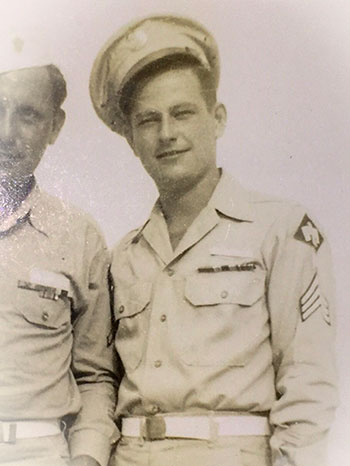
Photo courtesy of John Fulmer July 2018
Ralph Fulmer
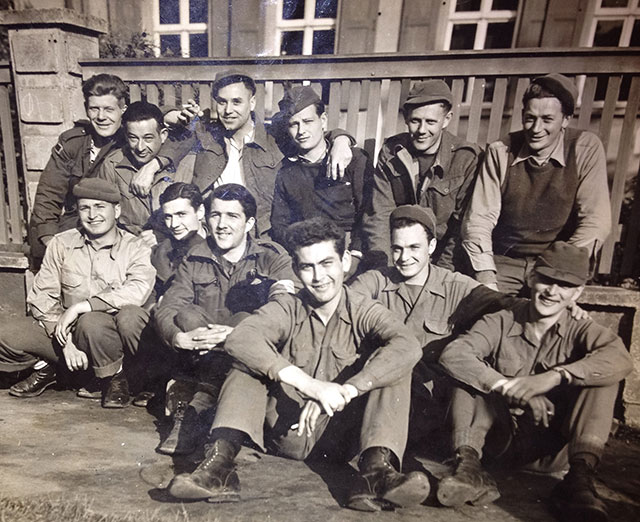
Photo courtesy of John Fulmer July 2018
Attached to the photo was a printed list of the men depicted and the following info:
ETO HQ 45 45693 3RD MAY 1945
CREDIT US ARMY SIGNAL COPRS
PHOTO TEC/4 GEORGE J BARRY 168
YANK/OUSSIE (sic) & BRITISH SOLDIERS
RELEASED BY RUSSIANS IN ELBA RIVER NAZI
CAMP NEAR ROSSLAU, L-R REAR: William Binghai,
Austrilain; (sic) Sgt. Charles Meyrositz, Philadelphia, PA;
Albert Cox, London, England; Sgt Ralph Fulrmer,
Winter
Garden FL;
Spud Ritchie, South Arican* (sic) Irish Army;
Sgt John Talaga, Union Town, PA; L-R Sgt
Leonard Graeser,
Des Moines, IA; Cpl Charles McMullen, Pittshburg (sic), PA;
Cpl Edward D Buckner, Winston Salem, NC; S/Sgt Guear M
Punxatawmy (sic)**, PA; Sgt Joseph T Dawson, Grand View, IN.
125 CAV RECON GP NUSA
*African - **Punxsutawney
Death 1999:
RALPH WILLIAM Sr Fulmer,
Service Info.: S SGT US ARMY WORLD WAR II,
Birth Date: 29 Feb 1924,
Death Date: 21 Jun 1999,
Cemetery: Winter Garden Cemetery,
Cemetery Address: Winter Garden, FL 34777
Obit:
RALPH WILLIAM FULMER SR., 75, 3567 County Road 405, Lake Panasoffkee, died Monday, June 21. Mr. Fulmer was a retired manager for ABC Liquors, Orlando. Born in Wetumpka, Ala., he moved to Central Florida in 1938. He was Protestant. He was an Army veteran of World War II. He was a prisoner of war. Survivors: wife, Ruth S.; son, Ralph Jr., Orlando; brothers, Robert Lee, Orlando, Gerald H., Wetumpka; sisters, Fannie Lou Traywick, Winter Garden, Sara Edwards, Eclectic, Ala., Ann Beasley, San Antonio; two grandchildren; two great-grandchildren. Becker Family Funeral Home, Clermont.
June 22, 1999 Orlando Sentinel
-
William E Hannah
Pretty common name.
Birth:
Enlistment:
Dog Tags: #35295652
Division: 179th
Capture: Nov 28, 1944
Camp: William E Hannah, #35295652 #063 Stalag 12A to 9B Limburg An Der Lahn Hessen-Nassau, Prussia 50-08, the camp at which John was first processed.
WWII POW:
Name: William E Hannah,
Report Date: 28 Nov 1944,
Latest Report Date: 1 Jun 1945,
Grade: Private,
Grade Notes: Cadet, USMA or Chief Warrant Officer or Private or Apprentice, Seaman,
Service Branch: Army,
Arm or Service: Infantry,
Arm or Service Code: Infantry,
Organization Type: Branch Immaterial/Infantry Division Band/Dental Corps/Medical Department,
Parent Unit Type: Group/Regiment/Commands/System,
Area Served: European Theatre: France,
Detaining Country: Germany,
Camp: 063,
Status: Returned to Military Control, Liberated or Repatriated,
Report Source: Individual has been reported through sources considered official.
NARA POW Record:
SERIAL NUMBER
35295652
HANNAH WILLIAM E
GRADE, ALPHA
Private
GRADE CODE
8
Cadet, USMA or Chief Warrant Officer or Private or Apprentice, Seaman
SERVICE CODE
1
ARMY
Infantry
ARM OR SERVICE CODE
10
INF: INFANTRY
DATE REPORT: DAY
28
MONTH
11
YEAR
1944
TYPE OF ORGANIZATION
740
Branch Immaterial/Infantry Division Band/Dental Corps/Medical Department
PARENT UNIT NUMBER
0179
PARENT UNIT TYPE
06
Group/Regiment/Commands/System
AREA
76
European Theatre: France
LATEST REPORT DATE: DAY (DD)
01
LATEST REPORT DATE: MONTH (MM)
06
LATEST REPORT DATE: YEAR (Y)
1945
SOURCE OF REPORT
1
Individual has been reported through sources considered official.
STATUS
8
Returned to Military Control, Liberated or Repatriated
DETAINING POWER
1
GERMANY
CAMP
063
Stalag 12A to 9B Limburg An Der Lahn Hessen-Nassau, Prussia 50-08
Last Report Date: June 1, 1945
Association with John Blanck: Same division, same capture date.
More:
-
Raymond A Jacks (1924-1997)
Birth: 1924, Alabama, lived Tennessee
Enlistment:
Raymond A Jacks
Birth Year:
1924
Race:
White, citizen (White)
Nativity State or Country:
Alabama
State of Residence:
Tennessee
County or City:
Franklin
Enlistment Date:
15 Dec 1943
Enlistment State:
Georgia
Enlistment City:
Fort Oglethorpe
Branch:
No branch assignment
Branch Code:
No branch assignment
Grade:
Private
Grade Code:
Private
Term of Enlistment:
Enlistment for the duration of the War or other emergency, plus six months, subject to the discretion of the President or otherwise according to law
Component:
Selectees (Enlisted Men)
Source:
Civil Life
Education:
Grammar school
Civil Occupation:
Farm hands, general farms
Marital Status:
Single, with dependents
Height:
00
Weight:
000
Dog Tags: 34920912
Division: 179
Capture: November 28, 1944
Camp: Raymond Jacks #34920912, Private, no camp listed
WWII POW:
Raymond A Jacks,
Report Date: 28 Nov 1944,
Latest Report Date: 18 Jul 1945,
Grade: Private,
Grade Notes: Cadet, USMA or Chief Warrant Officer or Private or Apprentice, Seaman,
Service Branch: Army,
Arm or Service: Infantry,
Arm or Service Code: Infantry,
Organization Type: Branch Immaterial/Infantry Division Band/Dental Corps/Medical Department,
Parent Unit Type: Group/Regiment/Commands/System,
Area Served: European Theatre: France,
Detaining Country: Germany,
Status: Returned to Military Control, Liberated or Repatriated,
Report Source: Individual has been reported through sources considered official.
NARA POW Record:
34920912
JACKS RAYMOND A
GRADE, ALPHA
PVT
Private
GRADE CODE
8
Cadet, USMA or Chief Warrant Officer or Private or Apprentice, Seaman
SERVICE CODE
1
ARMY
Infantry
ARM OR SERVICE CODE
10
INF: INFANTRY
DATE REPORT: DAY (
28
MONTH
11
YEAR
1944
TYPE OF ORGANIZATION
740
Branch Immaterial/Infantry Division Band/Dental Corps/Medical Department
PARENT UNIT NUMBER
0179
PARENT UNIT TYPE
06
Group/Regiment/Commands/System
AREA
76
European Theatre: France
LATEST REPORT DATE: DAY (DD)
18
LATEST REPORT DATE: MONTH (MM)
07
LATEST REPORT DATE: YEAR (Y)
1945
SOURCE OF REPORT
1
Individual has been reported through sources considered official.
STATUS
8
Returned to Military Control, Liberated or Repatriated
DETAINING POWER
1
GERMANY
Return Stateside:
Not listed on Ancestry.com under this spelling as of February 2010
Last Report Date: July 18, 1945
Association with John Blanck: Same division, same capture date, same camp
Death: Raymond A. Jacks
SSN:
412-26-7428 Last Residence: 31799, Thomasville, Thomas, Georgia, United States of America
Born: 15 Sep 1924
Died: 12 Sep 1997
State (Year) SSN issued: Tennessee (Before 1951)
More: Raymond A Jacks,
Service Info.: PFC US ARMY WORLD WAR II,
Birth Date: 15 Sep 1924,
Death Date: 12 Sep 1997,
Cemetery: Ochlocknee City Cemetery,
Cemetery Address: Ochlocknee, GA 31773
-
William D Keener (1924-2005)
Birth: 1924, North Carolina
Enlistment:
William D Keener
Birth Year:
1924
Race:
White, citizen (White)
Nativity State or Country:
North Carolina
State of Residence:
North Carolina
County or City:
Lincoln
Enlistment Date:
23 Feb 1944
Enlistment State:
North Carolina
Enlistment City:
Fort Bragg
Branch:
No branch assignment
Branch Code:
No branch assignment
Grade:
Private
Grade Code:
Private
Term of Enlistment:
Enlistment for the duration of the War or other emergency, plus six months, subject to the discretion of the President or otherwise according to law
Component:
Selectees (Enlisted Men)
Source:
Civil Life
Education:
4 years of high school
Civil Occupation:
Tinsmiths, coppersmiths, and sheet metal workers
Marital Status:
Married
Height:
11
Weight:
011
Dog Tags: 34961040
Division: 179th
Capture: November 28, 1944
Camp: William D Keener, Private, #34961040, #063 Stalag 12A to 9B Limburg An Der Lahn Hessen-Nassau, Prussia 50-08, the camp
at which John was first processed.
WWII POW:
William D Keener
Report Date: 28 Nov 1944,
Latest Report Date: 1 Jun 1945,
Grade: Private First Class,
Grade Notes: Second Lieutenant or Nurse or Dietitian or Physical
therapy aide or Private First Class or Ensign or Second Class, Seaman,
Service Branch: Army,
Arm or Service: Infantry,
Arm or Service Code: Infantry,
Organization Type: Branch Immaterial/Infantry Division Band/Dental Corps/Medical Department,
Parent Unit Type: Group/Regiment/Commands/System,
Area Served: European Theatre: France,
Detaining Country: Germany,
Camp: 063,
Status: Returned to Military Control, Liberated or Repatriated
Report Source: Individual has been reported through sources considered official.
NARA POW Record:
SERIAL NUMBER
34961040
KEENER WILLIAM D
GRADE, ALPHA
PFC
Private First Class
GRADE CODE
7
Second Lieutenant or Nurse or Dietitian or Physical therapy aide or Private First Class or Ensign or Second Class, Seaman
SERVICE CODE
1
ARMY
Infantry
ARM OR SERVICE CODE
10
INF: INFANTRY
DATE REPORT: DAY
28
MONTH
11
YEAR
1944
TYPE OF ORGANIZATION
740
Branch Immaterial/Infantry Division Band/Dental Corps/Medical Department
PARENT UNIT NUMBER
0179
PARENT UNIT TYPE
06
Group/Regiment/Commands/System
AREA
76
European Theatre: France
LATEST REPORT DATE: DAY (DD)
01
LATEST REPORT DATE: MONTH (MM)
06
LATEST REPORT DATE: YEAR (Y)
1945
SOURCE OF REPORT
1
Individual has been reported through sources considered official.
STATUS
8
Returned to Military Control, Liberated or Repatriated
DETAINING POWER
1
GERMANY
CAMP
063
Stalag 12A to 9B Limburg An Der Lahn Hessen-Nassau, Prussia 50-08
Return Stateside: Not listed on Ancestry.com under this spelling as of February 2010
Last Report Date: June 1, 1945
Association with John Blanck: Same division, same capture date.
Death:
William D. Keener
BIRTH:
14 Jan 1924
DEATH:
29 Nov 2005 - Lincolnton, Lincoln, North Carolina
CIVIL:
North Carolina
More: William Keener,
Gender: Male,
Birth Date: 14 Jan 1924,
Death Date: 29 Nov 2005,
Branch 1: ARMY,
Enlistment Date 1: 23 Feb 1944,
Release Date 1: 3 Dec 1945
-
Harry E. J. Kingston (1922-1991)
Birth:
Enlistment:
Harry E J Kingston,
Birth Year: 1920,
Race: White, citizen (White),
Nativity State or Country: Pennsylvania,
State of Residence: Pennsylvania,
County or City: Philadelphia,
Enlistment Date: 19 Nov 1942,
Enlistment State: Pennsylvania,
Enlistment City: Philadelphia,
Branch: Branch Immaterial - Warrant Officers, USA,
Branch Code: Branch Immaterial - Warrant Officers, USA,
Grade: Private,
Grade Code: Private,
Term of Enlistment: Enlistment for the duration of the War or other emergency,
plus six months, subject to the discretion of the President or otherwise according to law,
Component: Selectees (Enlisted Men),
Source: Civil Life,
Education: Grammar school,
Civil Occupation: Semiskilled routemen,
Marital Status: Single, with dependents,
Height: 67,
Weight: 147
Dog Tags: 33469422
Division:
Capture:
Camp: Not listed by NARA.
WWII POW:
Harry E J Kingston,
Report Date: 21 Dec 1944,
Latest Report Date: 12 Jun 1945,
Grade: Private First Class,
Grade Notes: Second Lieutenant or Nurse or Dietitian or Physical therapy aide
or Private First Class or Ensign or Second Class, Seaman,
Service Branch: Army,
Arm or Service: Infantry,
Arm or Service Code: Infantry,
Organization Type: Branch Immaterial/Infantry Division Band/Dental Corps/Medical Department,
Parent Unit Type: Group/Regiment/Commands/System,
Area Served: European Theatre: Germany,
Detaining Country: Germany,
Status: Returned to Military Control, Liberated or Repatriated
Report Source: Individual has been reported through sources considered official.
NARA POW Record:
33469422
KINGSTON HARRY E J
GRADE, ALPHA
PFC
Private First Class
GRADE CODE
7
Second Lieutenant or Nurse or Dietitian or Physical therapy aide or Private First Class or Ensign or Second Class, Seaman
SERVICE CODE
1
ARMY
Infantry
ARM OR SERVICE CODE
10
INF: INFANTRY
DATE REPORT: DAY
21
MONTH
12
YEAR
1944
TYPE OF ORGANIZATION
740
Branch Immaterial/Infantry Division Band/Dental Corps/Medical Department
PARENT UNIT NUMBER
0423
PARENT UNIT TYPE
06
Group/Regiment/Commands/System
AREA
72
European Theatre: Germany
LATEST REPORT DATE: DAY
12
MONTH
06
YEAR
1945
SOURCE OF REPORT
1
Individual has been reported through sources considered official.
STATUS
8
Returned to Military Control, Liberated or Repatriated
DETAINING POWER
1
GERMANY CAMP (not listed)
Return Stateside:
Last Report Date:
Association with John Blanck: Same camp
Death: ??
Harry Kingston,
Gender: Male,
Birth Date: 20 Apr 1920,
Death Date: 27 Mar 1991,
Cause of Death: Natural,
SSN: 198014593,
Branch 1: ARMY,
Enlistment Date 1: 3 Dec 1942,
Release Date 1: 5 Dec 1945
More:
In a letter included in Shadows
of Slaughterhouse Five, Harry Kingston
said he was born 20 April 1920 in Philadelphia and that his occupation
prior to the war was that of chief clerk for
J. W. Porter, grocery store.
Death: Harry Kingston
BIRTH: 20 Apr 1920
DEATH: 27 Mar 1991
CIVIL: Pennsylvania
Harry Kingston,
Birth Date: 20 Apr 1920,
Death Date: 27 Mar 1991,
Cause of Death: Natural,
SSN: 198014593,
Branch 1: ARMY,
Enlistment Date 1: 3 Dec 1942,
Release Date 1: 5 Dec 1945
-
Bert E Leonheart (1924-1983)
Birth: 1924, Pennsylvania
Enlistment:
Bert E Leonheart
Birth Year:
1924
Race:
White, citizen (White)
Enlistment Date:
5 Apr 1943
Enlistment State:
Pennsylvania
Enlistment City:
Erie
Branch:
No branch assignment
Branch Code:
No branch assignment
Grade:
Private
Grade Code:
Private
Term of Enlistment:
Enlistment for the duration of the War or other emergency, plus six months, subject to the discretion of the President or otherwise according to law
Component:
Selectees (Enlisted Men)
Source:
Civil Life
Education:
4 years of high school
Civil Occupation:
Unskilled occupations in production of rayon and allied products
Marital Status:
Single, without dependents
Height:
42
Weight:
115
Dog Tags: #33436448
Division: 179th
Capture: November 28, 1944
Camp: Bert E Leonheart, Corporal, #33436448, #063 Stalag 12A to 9B Limburg An Der Lahn Hessen-Nassau, Prussia 50-08, the camp at which John was first processed.
WWII POW:
Bert E Leonheart,
Report Date: 28 Nov 1944,
Latest Report Date: 30 Jun 1945,
Grade: Corporal,
Grade Notes: First Lieutenant or Chief nurse or Head dietitian or Head physical therapy aide or
Corporal or Technician 5th Grade or Lt. Jr. Grade or First Class, Seaman,
Service Branch: Army,
Arm or Service: Infantry,
Arm or Service Code: Infantry,
Organization Type: Branch Immaterial/Infantry Division Band/Dental Corps/Medical Department,
Parent Unit Type: Group/Regiment/Commands/System,
Area Served: European Theatre: France,
Detaining Country: Germany,
Camp: 063,
Status: Returned to Military Control, Liberated or Repatriated
Report Source: Individual has been reported through sources considered official.
NARA POW Record:
SERIAL NUMBER
33436448
LEONHEART BERT E
GRADE, ALPHA
CPL
Corporal
GRADE CODE
6
First Lieutenant or Chief nurse or Head dietitian or Head physical therapy aide or
Corporal or Technician 5th Grade or Lt. Jr. Grade or First Class, Seaman
SERVICE CODE
1
ARMY
Infantry
ARM OR SERVICE CODE
10
INF: INFANTRY
DATE REPORT: DAY
28
MONTH
11
YEAR
1944
TYPE OF ORGANIZATION
740
Branch Immaterial/Infantry Division Band/Dental Corps/Medical Department
PARENT UNIT NUMBER
0179
PARENT UNIT TYPE
06
Group/Regiment/Commands/System
AREA
76
European Theatre: France
LATEST REPORT DATE: DAY (DD)
30
LATEST REPORT DATE: MONTH (MM)
06
LATEST REPORT DATE: YEAR (Y)
1945
SOURCE OF REPORT
1
Individual has been reported through sources considered official.
STATUS
8
Returned to Military Control, Liberated or Repatriated
DETAINING POWER
1
GERMANY
CAMP
063
Stalag 12A to 9B Limburg An Der Lahn Hessen-Nassau, Prussia 50-08
Return Stateside: Not listed on Ancestry.com under this spelling as of February 2010
He was however listed on the Admiral Benson, page 10, 1945, June 12 New York City, 3A (Lib)
78755 Leonheart, Bert E
Cpl #33436448 179th Inf
22 April 1945 Iden $50.44 2500 Fr.
Rd Seagertown, Penna
Last Report Date: June 30, 1945
Association with John Blanck: Same division, same capture date, returned stateside same ship.
Death: Bert Leonheart
BIRTH: 11 Nov 1924
DEATH: Dec 1983
CIVIL: Pennsylvania
OTHER: Huntington Beach, Orange, California, United States of America
More: Bert Leonheart,
Birth Date: 11 Nov 1924,
Death Date: 19 Dec 1983,
SSN: 202140551,
Branch 1: ARMY,
Enlistment Date 1: 12 Apr 1943,
Release Date 1: 18 Dec 1945
-
Howard M Linthicum (1911-1969)
Birth: March 26, 1911, North Carolina
Enlistment:
LINTHICUM HOWARD M, PFC, born 1911, North Carolina, Randolph, Enlistment date, 15 January 1944, South Carolina, Camp Croft, private,
skilled in manufacture of knit goods, married
Dog Tags: 34898865
Division: 179th
Capture: Nov 28, 1944
Camp:
Stalag 4B Muhlberg Sachsen 51-13
WWII POW: Howard M Linthicum,
Report Date: 28 Nov 1944,
Latest Report Date: 12 Jun 1945,
Grade: Private First Class,
Grade Notes: Second Lieutenant or Nurse or Dietitian or Physical therapy aide or Private
First Class or Ensign or Second Class, Seaman,
Service Branch: Army,
Arm or Service: Infantry,
Arm or Service Code: Infantry,
Organization Type: Branch Immaterial/Infantry Division Band/Dental Corps/Medical Department,
Parent Unit Type: Group/Regiment/Commands/System,
Area Served: European Theatre: France,
Detaining Country: Germany,
Camp: 00,6
Status: Returned to Military Control, Liberated or Repatriated,
Report Source: Individual has been reported through sources considered official.
NARA POW:
SERIAL NUMBER
34898865
LINTHICUM HOWARD M
Private First Class
GRADE CODE
7
Second Lieutenant or Nurse or Dietitian or Physical therapy aide or Private First Class or Ensign or Second Class, Seaman
SERVICE CODE
1
ARMY
Infantry
ARM OR SERVICE CODE
10
INF: INFANTRY
DATE REPORT: DAY
28
MONTH
11
YEAR
1944
TYPE OF ORGANIZATION
740
Branch Immaterial/Infantry Division Band/Dental Corps/Medical Department
PARENT UNIT NUMBER
0179
PARENT UNIT TYPE
06
Group/Regiment/Commands/System
AREA
76
European Theatre: France
LATEST REPORT DATE: DAY (DD)
12
12
LATEST REPORT DATE: MONTH (MM)
06
06
LATEST REPORT DATE: YEAR (Y)
5
1945
SOURCE OF REPORT
1
Individual has been reported through sources considered official.
STATUS
8
Returned to Military Control, Liberated or Repatriated
DETAINING POWER
1
GERMANY
CAMP
006
Stalag 4B Muhlberg Sachsen 51-13
Return Stateside:
4 B (Lib) #311274, Linthicum, Howard M.
pfc #34898865 179 INf, 17 May '45 $75.00 -- 3717 Fr, P. O. Box 323 Randlemann, NC, arrival
12 June 1945 New York on the Admiral Benson, Movement Orders of Liberated Prisoners of War
Association with John Blanck:
Same Division, same capture date, same camp, returned stateside same ship
Death: Howard Monroe Linthicum, age 58, August 12, 1969,
Randleman, North Carolina,
Carcinoma of Esopjagus.
Birth: Mar. 11, 1911,
Randolph County,
North Carolina, USA,
Death: Aug. 12, 1969,
Durham,
Durham County,
North Carolina, USA
Burial:
Caraway Baptist Church Cemetery,
Sophia,
Randolph County,
North Carolina, USA, Find a Grave
More:
-
Joseph G Manzari (1923-2004)
Birth: 1923, New York
Enlistment:
Joseph G Manzari
Birth Year:
1923
Race:
White, citizen (White)
Nativity State or Country:
New York
State of Residence:
New York
County or City:
Suffolk
Enlistment Date:
8 Feb 1943
Enlistment State:
New York
Enlistment City:
New York City
Branch:
Branch Immaterial - Warrant Officers, USA
Branch Code:
Branch Immaterial - Warrant Officers, USA
Grade:
Private
Grade Code:
Private
Term of Enlistment:
Enlistment for the duration of the War or other emergency, plus six months, subject to the discretion of the President or otherwise according to law
Component:
Selectees (Enlisted Men)
Source:
Civil Life
Education:
2 years of high school
Civil Occupation:
Apprentices to other trades
Marital Status:
Single, without dependents
Height:
68
Weight:
133
Dog Tags: 32796919
Division: 179
Capture: November 28, 1944
POW Listed in Long Island City Journal Star in 1945:
ARMY PRISONERS Interned in Germany - Joseph G. Manzari, pvt. son of Mrs. Margaret Manzari 350 South Deleware ave, Lindenhurst.
Camp: Joseph G Manzari, #32796919, private, #063 Stalag 12A to 9B Limburg An Der Lahn Hessen-Nassau, Prussia 50-08, the camp at which
John was first processed.
WWII POW:
Joseph G Manzari,
Report Date: 28 Nov 1944,
Latest Report Date: Jun 1945,
Grade: Private,
Grade Notes: Cadet, USMA or Chief Warrant Officer or Private or Apprentice, Seaman,
Service Branch: Army,
Arm or Service: Infantry,
Arm or Service Code: Infantry,
Organization Type: Branch Immaterial/Infantry Division Band/Dental Corps/Medical Department,
Parent Unit Type: Group/Regiment/Commands/System,
Area Served: European Theatre: France,
Detaining Country: Germany,
Camp: 063,
Status: Returned to Military Control, Liberated or Repatriated,
Report Source: Individual has been reported through sources considered official.
NARA POW Record:
32796919
MANZARI JOSEPH G
GRADE, ALPHA
PVT
Private
GRADE CODE
8
Cadet, USMA or Chief Warrant Officer or Private or Apprentice, Seaman
SERVICE CODE
1
ARMY
Infantry
ARM OR SERVICE CODE
10
INF: INFANTRY
DATE REPORT: DAY
28
MONTH
11
YEAR
1944
TYPE OF ORGANIZATION
740
Branch Immaterial/Infantry Division Band/Dental Corps/Medical Department
PARENT UNIT NUMBER
0179
PARENT UNIT TYPE
06
Group/Regiment/Commands/System
AREA
76
European Theatre: France
LATEST REPORT DATE: DAY (DD)
04
04
LATEST REPORT DATE: MONTH (MM)
06
06
LATEST REPORT DATE: YEAR (Y)
5
1945
SOURCE OF REPORT
1
Individual has been reported through sources considered official.
STATUS
8
Returned to Military Control, Liberated or Repatriated
DETAINING POWER
1
GERMANY
CAMP
063
Stalag 12A to 9B Limburg An Der Lahn Hessen-Nassau, Prussia 50-08
Return Stateside:
12 June 1945 Admiral Benson (lib) #311045 Manzari, Joseph G Pvt #3-796919 179th Infantry, 8 May
45 Iden $50.44 Fr 1,500 350 Delaware Ave Lindenhurst NY
Association with John Blanck: Same division, same capture date
Death: Joseph G Sr Manzari
Service Info.:
PFC US ARMY WORLD WAR II
Birth Date:
15 Nov 1923
Death Date:
11 Sep 2003
Service Start Date:
15 Feb 1943
Interment Date:
5 Jan 2004
Cemetery:
Long Island National Cemetery
Cemetery Address:
2040 Wellwood Avenue Farmingdale, NY 11735-1211
Buried At:
Section 2x Site 680
Joseph Manzari
BIRTH: 15 Nov 1923
DEATH: 11 Sep 2003 - Farmingville, Suffolk, New York, United States of America
CIVIL: New York
OTHER: Farmingville, Suffolk, New York, United States of America
More:
Gertrude Manzari,
Service Info.: PVT US ARMY,
Birth Date: 23 Nov 1912,
Death Date: 18 Feb 1981,
Relation: Wife Of Manzari, Joseph,
Interment Date: 20 Feb 1981,
Cemetery: Long Island National Cemetery,
Cemetery Address: 2040 Wellwood Avenue Farmingdale, NY 11735-1211,
Buried At: Section R Site 4441
-
Roy A Reed
Very common name.
Birth:
Enlistment:
Dog Tags: 42080815
Division: 179
Capture: November 28, 1944
Camp: REED ROY A, PVT, camp #006, Stalag 4B Muhlberg Sachsen 51-13.
WWII POW:
Roy A Reed,
Report Date: 28 Nov 1944,
Latest Report Date: Jun 1945,
Grade: Private,
Grade Notes: Cadet, USMA or Chief Warrant Officer or Private or Apprentice, Seaman,
Service Branch: Army,
Arm or Service: Infantry,
Arm or Service Code: Infantry,
Organization Type: Branch Immaterial/Infantry Division Band/Dental Corps/Medical Department,
Parent Unit Type: Group/Regiment/Commands/System,
Area Served: European Theatre: France,
Detaining Country: Germany,
Camp: 006,
Status: Returned to Military Control, Liberated or Repatriated,
Report Source: Individual has been reported through sources considered official.
NARA POW Record:
42080815
REED ROY A
GRADE, ALPHA
PVT
Private
GRADE CODE
8
Cadet, USMA or Chief Warrant Officer or Private or Apprentice, Seaman
SERVICE CODE
1
ARMY
Infantry
ARM OR SERVICE CODE
10
INF: INFANTRY
DATE REPORT: DAY
28
MONTH
11
YEAR
1944
TYPE OF ORGANIZATION
740
Branch Immaterial/Infantry Division Band/Dental Corps/Medical Department
PARENT UNIT NUMBER
0179
PARENT UNIT TYPE
06
Group/Regiment/Commands/System
AREA
76
European Theatre: France
LATEST REPORT DATE: DAY (DD)
06
06
LATEST REPORT DATE: MONTH (MM)
06
06
LATEST REPORT DATE: YEAR (Y)
5
1945
SOURCE OF REPORT
1
Individual has been reported through sources considered official.
STATUS
8
Returned to Military Control, Liberated or Repatriated
DETAINING POWER
1
GERMANY
CAMP
006
Stalag 4B Muhlberg Sachsen 51-13
Return Stateside: Not listed with that Dog Tag #.
Association with John Blanck: Same division, same date of capture, same camp
Death:
More:
-
Sam Sharaba (1925-1995)
Birth: 1925, Ohio
Enlistment: Sam Sharaba born 1925, Ohio, enlistment date 4 Aug 1943, Fort Hayes, Columbus, private, 3 years
High School, single, actor
Dog Tags: 35765336
Division: 179
Capture: November 28, 1944
Camp: Sam Sharaba, Corporal #35765336, sent to Camp #004, Stalag 3B Furstenberg Brandenburg, Prussia
WWII POW:
Sam Sharaba,
Report Date: 28 Nov 1944,
Latest Report Date: 12 Jun 1945,
Grade: Corporal,
Grade Notes: First Lieutenant or Chief nurse or Head dietitian or Head physical therapy aide or
Corporal or Technician 5th Grade or Lt. Jr. Grade or First Class, Seaman,
Service Branch: Army,
Arm or Service: Infantry,
Arm or Service Code: Infantry,
Organization Type: Branch Immaterial/Infantry Division Band/Dental Corps/Medical Department,
Parent Unit Type: Group/Regiment/Commands/System,
Area Served: European Theatre: France,
Detaining Country: Germany,
Camp: 004,
Status: Returned to Military Control, Liberated or Repatriated,
Report Source: Individual has been reported through sources considered official.
NARA POW Record:
35765336
SHARABA SAM
GRADE, ALPHA
CPL
Corporal
GRADE CODE
6
First Lieutenant or Chief nurse or Head dietitian or Head physical therapy aide or Corporal or Technician 5th Grade or Lt. Jr. Grade or First Class, Seaman
SERVICE CODE
1
ARMY
Infantry
ARM OR SERVICE CODE
10
INF: INFANTRY
DATE REPORT: DAY (DD)
28
MONTH
11
YEAR (
1944
TYPE OF ORGANIZATION
740
Branch Immaterial/Infantry Division Band/Dental Corps/Medical Department
PARENT UNIT NUMBER
0179
PARENT UNIT TYPE
06
Group/Regiment/Commands/System
AREA
76
European Theatre: France
LATEST REPORT DATE: DAY (DD)
12
12
LATEST REPORT DATE: MONTH (MM)
06
06
LATEST REPORT DATE: YEAR (Y)
5
1945
SOURCE OF REPORT
1
Individual has been reported through sources considered official.
STATUS
8
Returned to Military Control, Liberated or Repatriated
DETAINING POWER
1
GERMANY
CAMP
004
Stalag 3B Furstenberg Brandenburg, Prussia (Also KDOS [USA] #1-5; ARB BTNS 225-255) 52-14
Return Stateside: Sam Sharaba Cpl #3576336 cannot read (lib) #0788-4, 179th Infantry, 3 May 45 Iden $20.17 1000 FR 1835 Penrose Ave, E Cleveland, Ohio, Jun 30, 1945,
Monticello, Port of New York
Association with John Blanck: Same division, same capture date, same camp
Death: Death SSDI
28 Feb 1925, died 30 June 1995, Olmstead Falls, Cuyahoga, Ohio olso Ohio deaths Ancestry.com
More: Sam Sharaba,
Gender: Male,
Birth Date: 28 Feb 1925,
Death Date: 30 Jun 1995,
SSN: 269203060,
Branch 1: ARMY,
Enlistment Date 1: 4 Aug 1943,
Release Date 1: 4 Sep 1945
-
John Stepovich (1922-2010)
Birth: Aliquippa, Pa
Enlistment:
???? John Stepovich
Birth Year:
1922
Race:
White, citizen (White)
Nativity State or Country:
Ohio
State of Residence:
Ohio Enlistment Date:
28 Dec 1943
Enlistment State:
Pennsylvania
Enlistment City:
Pittsburgh
Branch:
No branch assignment
Branch Code:
No branch assignment
Grade:
Private
Grade Code:
Private
Term of Enlistment:
Enlistment for the duration of the War or other emergency, plus six months, subject to the discretion of the President or otherwise according to law
Component:
Selectees (Enlisted Men)
Source:
Civil Life Education:
1 year of high school
Marital Status:
Single, without dependents
Height:
00
Weight:
000
Dog Tags: 33715035
Division: 179
Capture: November 28, 1944
Camp: John Stepovich, #33715035, #063 Stalag 12A to 9B Limburg An Der Lahn Hessen-Nassau, Prussia 50-08, the camp at which John was
first processed.
WWII POW:
John Stepovich,
Report Date: 28 Nov 1944,
Latest Report Date: Jun 1945,
Grade: Private,
Grade Notes: Cadet, USMA or Chief Warrant Officer or Private or Apprentice, Seaman,
Service Branch: Army,
Arm or Service: Infantry,
Arm or Service Code: Infantry,
Organization Type: Branch Immaterial/Infantry Division Band/Dental Corps/Medical Department,
Parent Unit Type: Group/Regiment/Commands/System,
Area Served: European Theatre: France,
Detaining Country: Germany,
Camp: 063,
Status: Returned to Military Control, Liberated or Repatriated,
Report Source: Individual has been reported through sources considered official.
NARA POW Record:
33715035
STEPOVICH JOHN
GRADE, ALPHA
PVT
Private
GRADE CODE
8
Cadet, USMA or Chief Warrant Officer or Private or Apprentice, Seaman
SERVICE CODE
1
ARMY
Infantry
ARM OR SERVICE CODE
10
INF: INFANTRY
DATE REPORT: DAY
28
MONTH
11
YEAR
1944
TYPE OF ORGANIZATION
740
Branch Immaterial/Infantry Division Band/Dental Corps/Medical Department
PARENT UNIT NUMBER
0179
PARENT UNIT TYPE
06
Group/Regiment/Commands/System
AREA
76
European Theatre: France
LATEST REPORT DATE: DAY (DD)
09
09
LATEST REPORT DATE: MONTH (MM)
06
06
LATEST REPORT DATE: YEAR (Y)
5
1945
SOURCE OF REPORT
1
Individual has been reported through sources considered official.
STATUS
8
Returned to Military Control, Liberated or Repatriated
DETAINING POWER
1
GERMANY
CAMP
063
Stalag 12A to 9B Limburg An Der Lahn Hessen-Nassau, Prussia 50-08
Return Stateside:Not under that spelling on Ancestry.com
Association with John Blanck: In same division, captured same day
Death: John Stepovich,
Gender: Male,
Birth Date: 21 Apr 1922,
Death Date: 28 Jul 2010,
Branch 1: ARMY,
Enlistment Date 1: 18 Jan 1944,
Release Date 1: 23 Nov 1945
More:
Image of John Stepovich
-
Robert Irving Sulzer (1916-2008)
Birth: May 14, 1916 Cook Co., Illinois
Enlistment: Not under that spelling on Ancestry.com
Dog Tags: 36784172
Division: 179
Capture: November 28, 1944
Camp: SULZER ROBERT I, PVT, camp #006, Stalag 4B Muhlberg Sachsen 51-13.
WWII POW:
Robert I Sulzer,
Report Date: 28 Nov 1944,
Latest Report Date: 14 Jul 1945,
Grade: Private,
Grade Notes: Cadet, USMA or Chief Warrant Officer or Private or Apprentice, Seaman,
Service Branch: Army,
Arm or Service: Infantry,
Arm or Service Code: Infantry,
Organization Type: Branch Immaterial/Infantry Division Band/Dental Corps/Medical Department,
Parent Unit Type: Group/Regiment/Commands/System,
Area Served: European Theatre: France,
Detaining Country: Germany,
Camp: 006,
Status: Returned to Military Control, Liberated or Repatriated,
Report Source: Individual has been reported through sources considered official.
NARA POW Record:
36784172
SULZER ROBERT I
GRADE, ALPHA
PVT
Private
GRADE CODE
8
Cadet, USMA or Chief Warrant Officer or Private or Apprentice, Seaman
SERVICE CODE
1
ARMY
Infantry
ARM OR SERVICE CODE
10
INF: INFANTRY
DATE REPORT: DAY
28
MONTH
11
YEAR
1944
TYPE OF ORGANIZATION
740
Branch Immaterial/Infantry Division Band/Dental Corps/Medical Department
PARENT UNIT NUMBER
0179
PARENT UNIT TYPE
06
Group/Regiment/Commands/System
AREA
76
European Theatre: France
LATEST REPORT DATE: DAY (DD)
14
14
LATEST REPORT DATE: MONTH (MM)
7
7
LATEST REPORT DATE: YEAR (Y)
5
1945
SOURCE OF REPORT
1
Individual has been reported through sources considered official.
STATUS
8
Returned to Military Control, Liberated or Repatriated
DETAINING POWER
1
GERMANY
CAMP
006
Stalag 4B Muhlberg Sachsen 51-13
Return Stateside: Admiral Benson June 12, 1945
4B (lib) 31---8 Sulzer, Robert I Pvt 36784172, 179 Inf 14 May 45 Iden $50. 44 - 2500 Fr 11732 Normal
Ave,
Chicago, Ill
National Jewish Welfare Board: Prisoner,
Sulzer, Robert I Pvt., next of kin, Mrs, Elsie Modrow Sulzer, mother,
11732 Normal Ave. Chicago, Army.
Association with John Blanck:
Death:
Robert Irving Sulzer,
Last Residence: 85351 Sun City, Maricopa, Arizona, USA,
BORN: 14 May 1916,
Died: 1 Nov 2008,
State (Year) SSN issued: Illinois (Before 1951)
More: Sulzer, Robert I.
92 of Sun City, passed away on November 1, 2008. He was born in Chicago, IL.
Robert is an Ex-P.O.W. He honorably served his country in the United States
Army during WWII. Robert was captured and was held in a German Prison
Camp until the war ended in 1945. After the war he returned home
and was a Firefighter with Chicago F.D. for 25yrs. Robert and his
wife moved to Sun City, AZ in 1971. He was a member of VFW
Post 6308, Sun City and P.O.W. Agua Fria. Robert
is survived by his beloved wife of 61 years, Evelyn and daughter,
Susan. Private interment will be held at the National M
emorial Cemetery of Arizona. Arrangements entrusted to Sunland Mortuary.
Published in The Arizona Republic on 11/4/2008
-
Carl W Taylor
Very common name.
Birth:
Enlistment:
Dog Tags: 34591995
Division: 179
Capture: November 28, 1944
Camp: Carl W Taylor #34591995 Private, #063 Stalag 12A to 9B Limburg An Der Lahn Hessen-Nassau, Prussia 50-08, the camp at which
John was first processed.
WWII POW:
Carl W Taylor,
Report Date: 28 Nov 1944,
Latest Report Date: 14 Jun 1945,
Grade: Private First Class,
Grade Notes: Second Lieutenant or Nurse or Dietitian or Physical therapy
aide or Private First Class or Ensign or Second Class, Seaman,
Service Branch: Army,
Arm or Service: Infantry,
Arm or Service Code: Infantry,
Organization Type: Branch Immaterial/Infantry Division Band/Dental Corps/Medical Department,
Parent Unit Type: Group/Regiment/Commands/System,
Area Served: European Theatre: France,
Detaining Country: Germany,
Camp: 063,
Status: Returned to Military Control, Liberated or Repatriated,
Report Source: Individual has been reported through sources considered official.
NARA POW Record:
34591995
TAYLOR CARL W
GRADE, ALPHA
PFC
Private First Class
GRADE CODE
7
Second Lieutenant or Nurse or Dietitian or Physical therapy aide or Private First Class or Ensign or Second Class, Seaman
SERVICE CODE
1
ARMY
Infantry
ARM OR SERVICE CODE
10
INF: INFANTRY
DATE REPORT: DAY (
28
MONTH
11
YEAR
1944
TYPE OF ORGANIZATION
740
Branch Immaterial/Infantry Division Band/Dental Corps/Medical Department
PARENT UNIT NUMBER
0179
PARENT UNIT TYPE
06
Group/Regiment/Commands/System
AREA
76
European Theatre: France
LATEST REPORT DATE: DAY (DD)
14
14
LATEST REPORT DATE: MONTH (MM)
06
06
LATEST REPORT DATE: YEAR (Y)
5
1945
SOURCE OF REPORT
1
Individual has been reported through sources considered official.
STATUS
8
Returned to Military Control, Liberated or Repatriated
DETAINING POWER
1
GERMANY
CAMP
063
Stalag 12A to 9B Limburg An Der Lahn Hessen-Nassau, Prussia 50-08
Return Stateside:
Association with John Blanck:
Death:
More:
-
Kurt Vonnegut Jr (1922-2007)
Birth: November 11, 1922, Indianapolis, Indiana
Enlistment: Not listed on Ancestry perhaps because he enlisted in the reserves.
In the Army reserves in November 1942 per internet.
Dog Tags: 12102964
Division: 423rd Infantry Regiment of the 106th Division.
He went overseas in November 1944.
See
Kurt Vonnegut Jr. in WW II
Capture: December 21, 1944
Camp: 4 B Muhlberg
WWII POW:
Kurt Jr Vonnegut,
Report Date: 21 Dec 1944,
Latest Report Date: 13 Jul 1945,
Grade: Private First Class,
Grade Notes: Second Lieutenant or Nurse or Dietitian or Physical therapy aide or Private
First Class or Ensign or Second Class, Seaman,
Service Branch: Army,
Arm or Service: Infantry,
Arm or Service Code: Infantry,
Organization Type: Branch Immaterial/Infantry Division Band/Dental Corps/Medical Department,
Parent Unit Type: Group/Regiment/Commands/System,
Area Served: European Theatre: Germany,
Detaining Country: Germany,
Camp: 006,
Status: Returned to Military Control, Liberated or Repatriated,
Report Source: Individual has been reported through sources considered official.
NARA POW Record:
12102964
VONNEGUT KURT JR
GRADE, ALPHA
PFC
Private First Class
GRADE CODE
7
Second Lieutenant or Nurse or Dietitian or Physical therapy aide or Private First Class or Ensign or Second Class, Seaman
SERVICE CODE
1
ARMY
Infantry
ARM OR SERVICE CODE
10
INF: INFANTRY
DATE REPORT: DAY
21
MONTH
12
YEAR
1944
TYPE OF ORGANIZATION
740
Branch Immaterial/Infantry Division Band/Dental Corps/Medical Department
PARENT UNIT NUMBER
0423
PARENT UNIT TYPE
06
Group/Regiment/Commands/System
AREA
72
European Theatre: Germany
LATEST REPORT DATE: DAY
13
MONTH
07
YEAR
1945
SOURCE OF REPORT
1
Individual has been reported through sources considered official.
STATUS
8
Returned to Military Control, Liberated or Repatriated
DETAINING POWER
1
GERMANY
CAMP
006
Stalag 4B Muhlberg Sachsen 51-13
Return Stateside: Not listed Ancestry.com February 2010
Latest Report Date: July 13, 1945
Association with John Blanck: Same camp
Death: April 11, 2007
Kurt Vonnegut,
Birth Date: 11 Nov 1922,
Death Date: 11 Apr 2007,
Branch 1: A,
Enlistment Date 1: 6 Apr 1943,
Release Date 1: 4 Dec 1945.
More:
In a letter to his father in May 1944 Kurt Vonnegut describes his capture, the transportation
from Limberg to Stalag 4 B in Muhlberg and the liberation by the Russians.
Wednesday, 18 November 2009
Slaughterhouse Five
Michigan Quarterly Review
|

